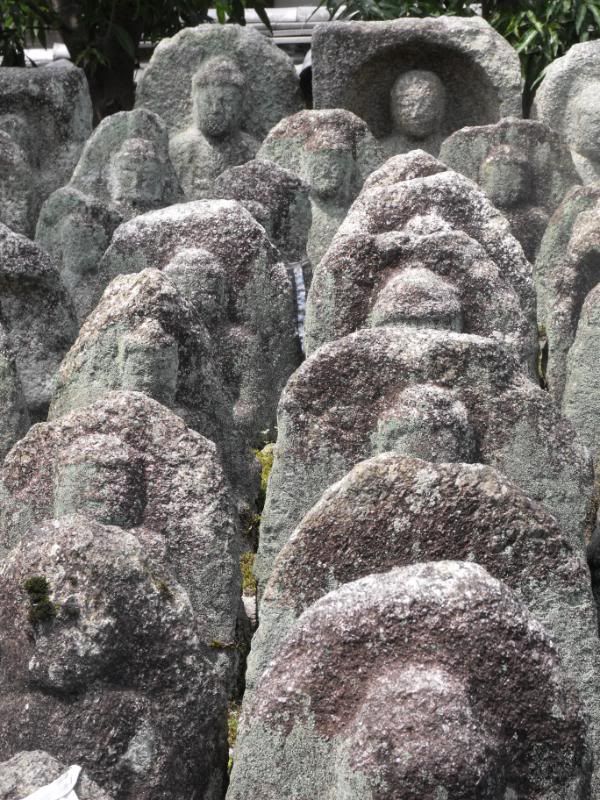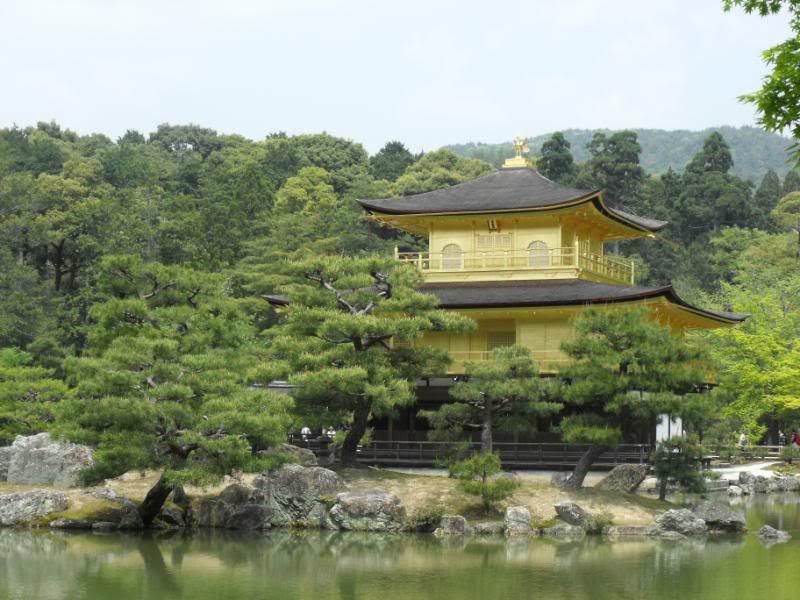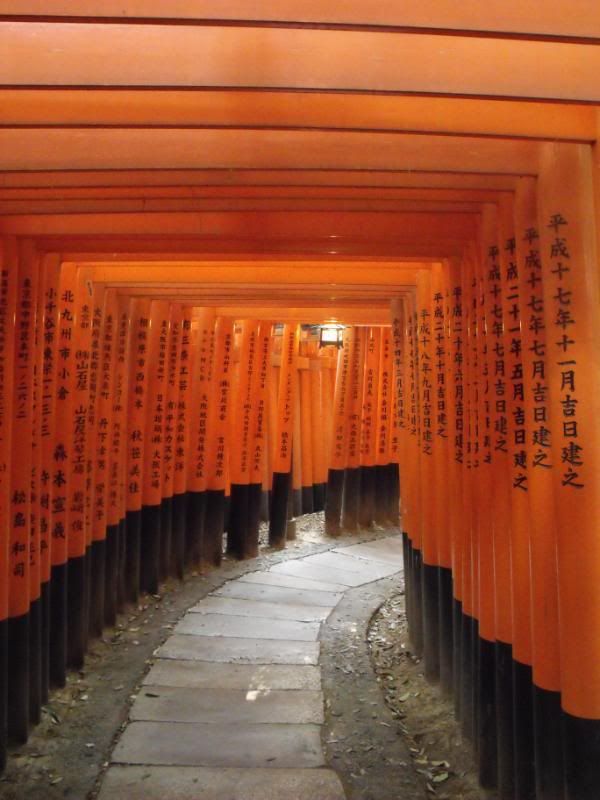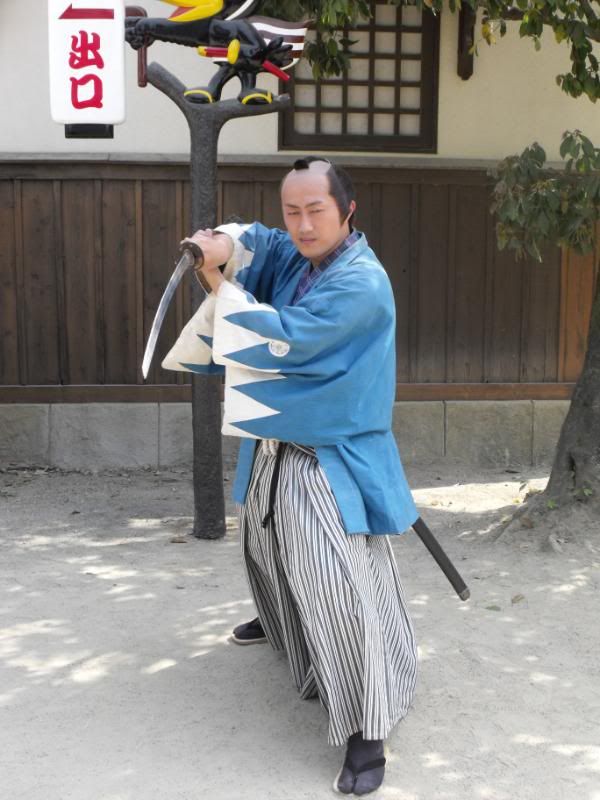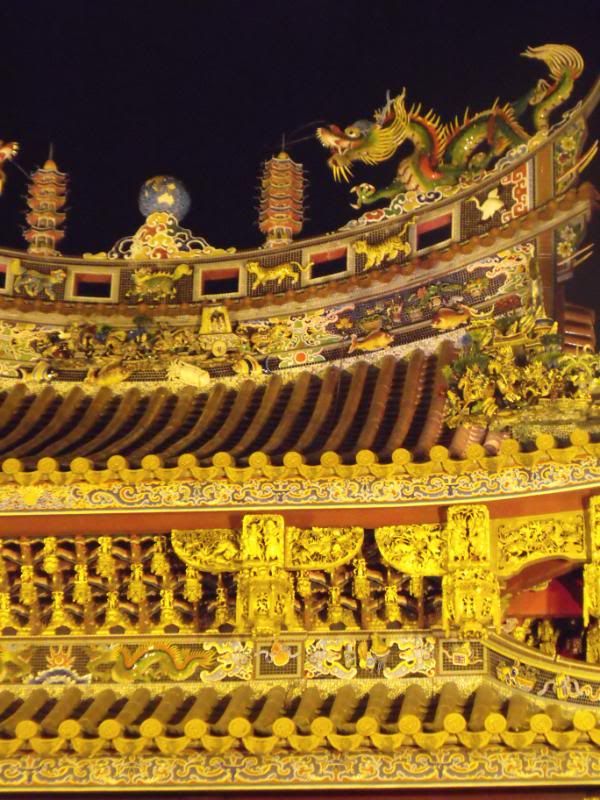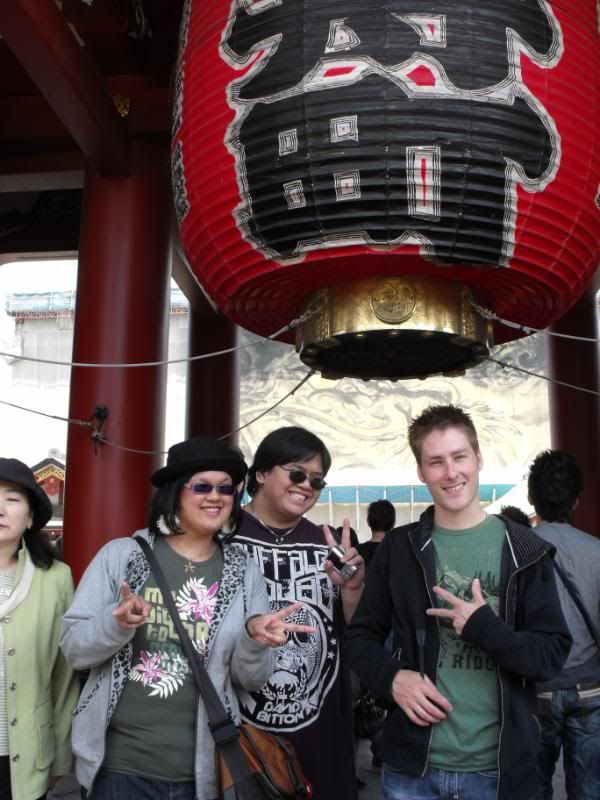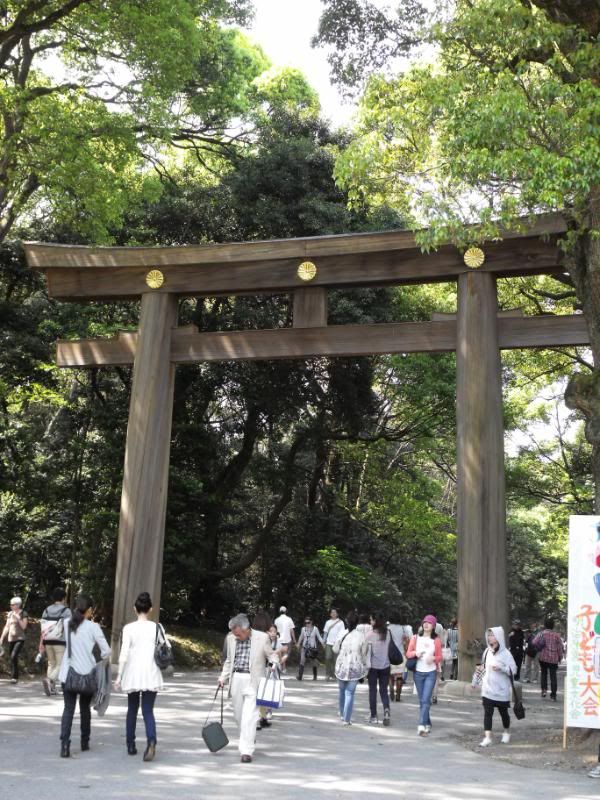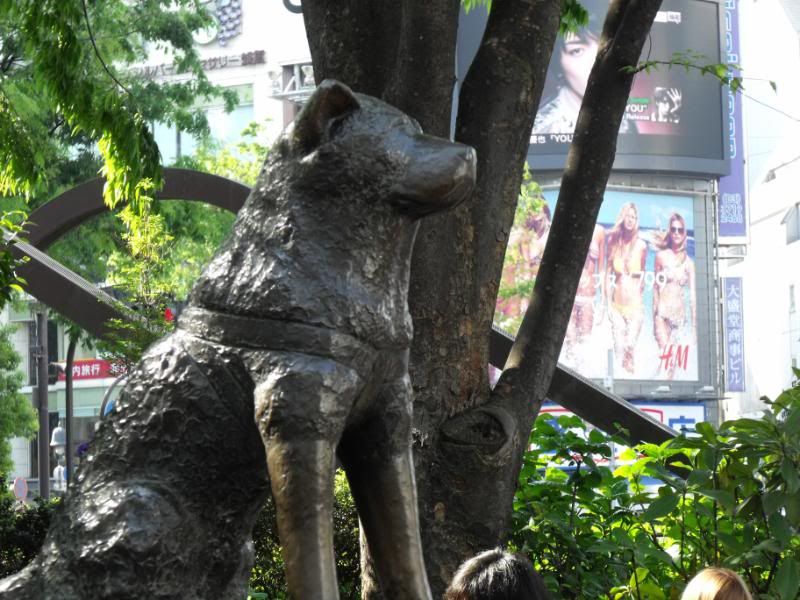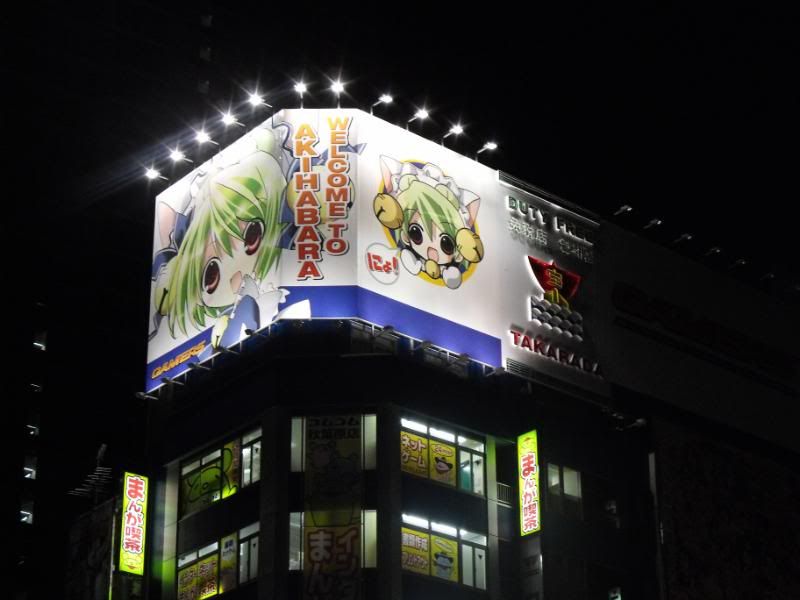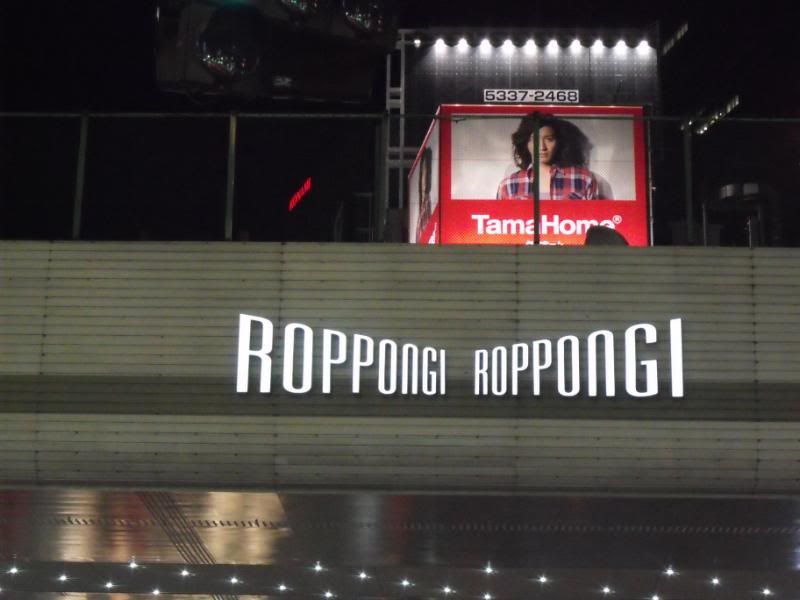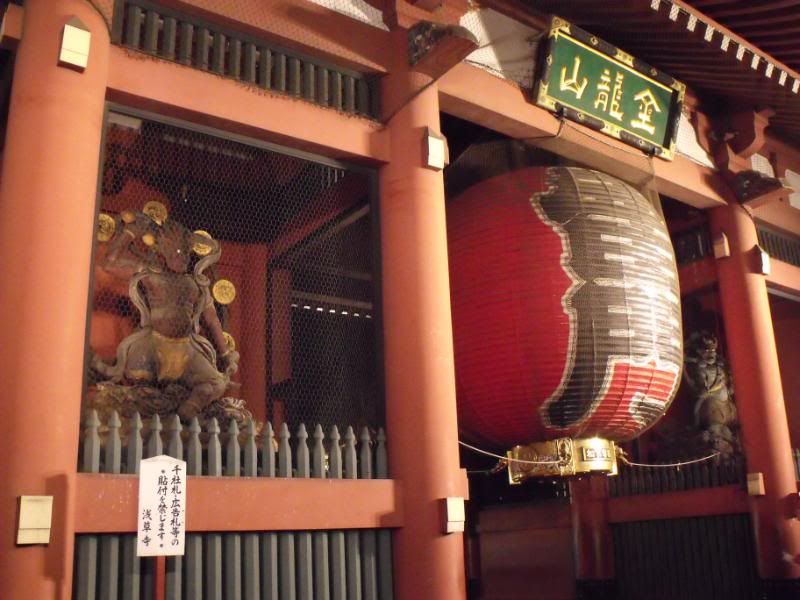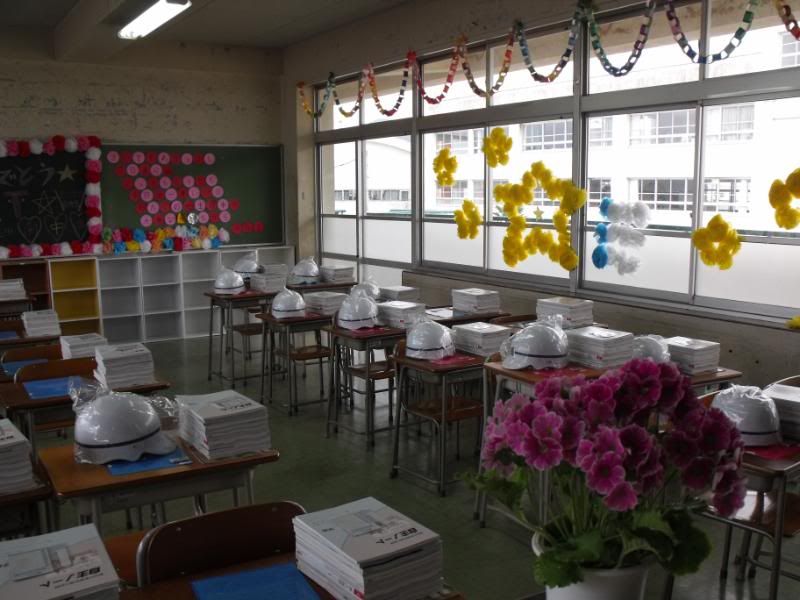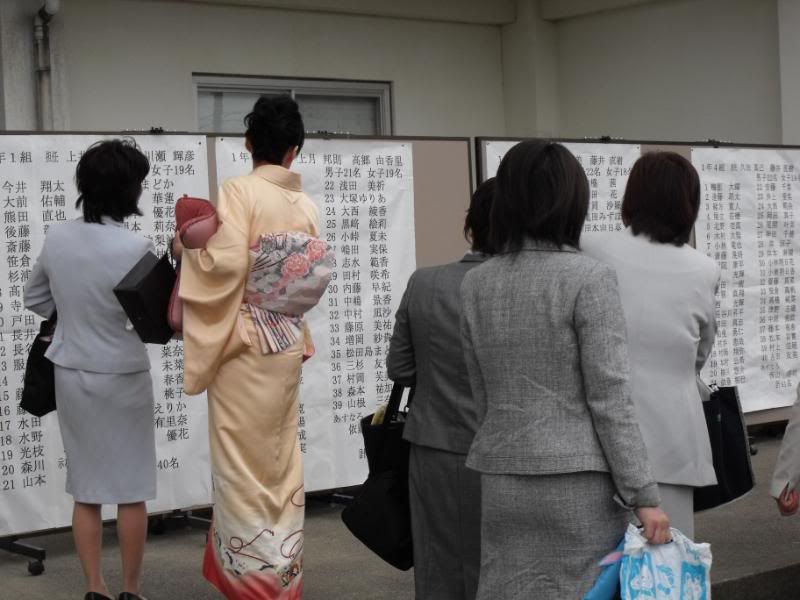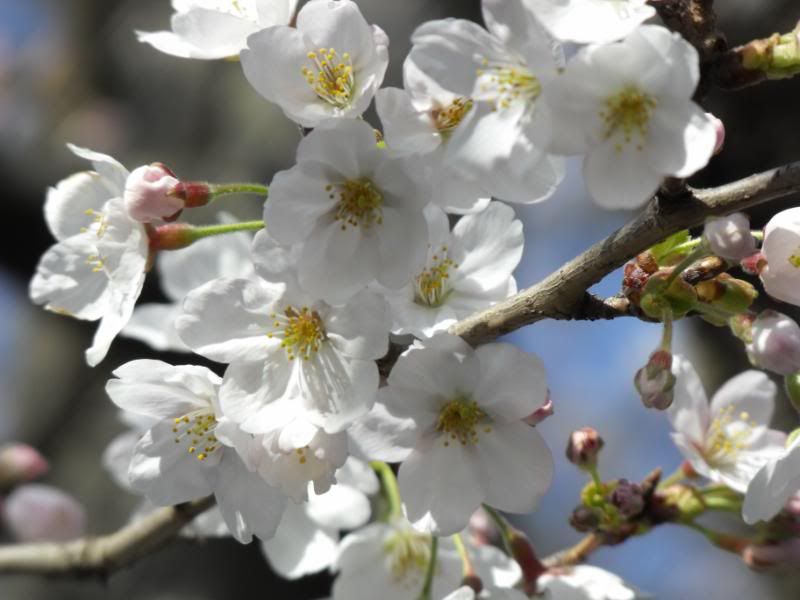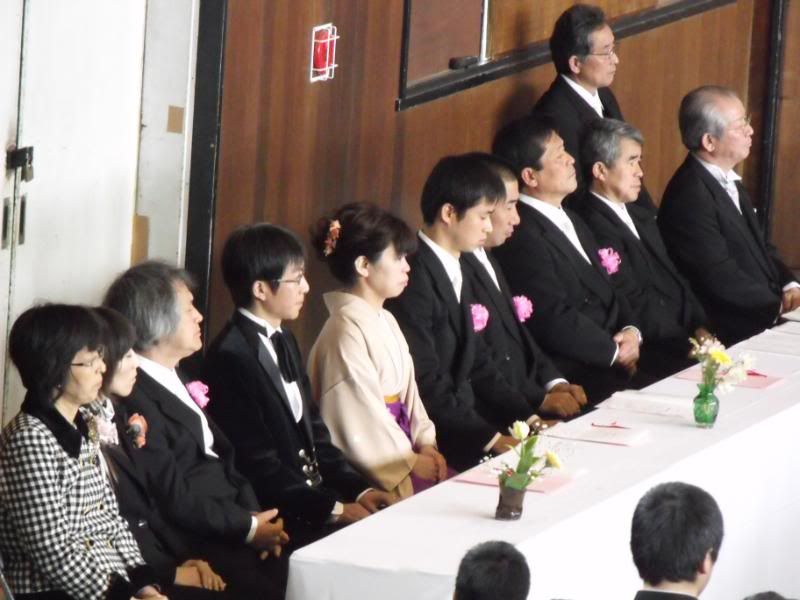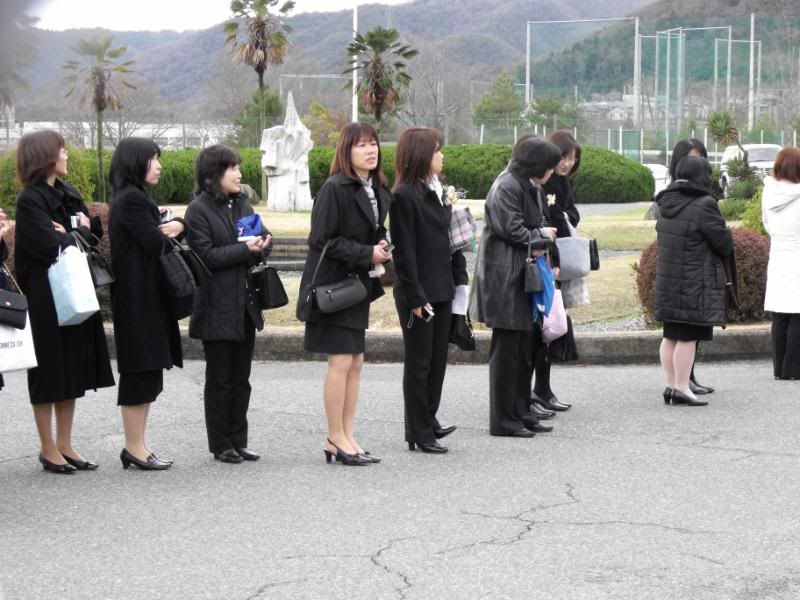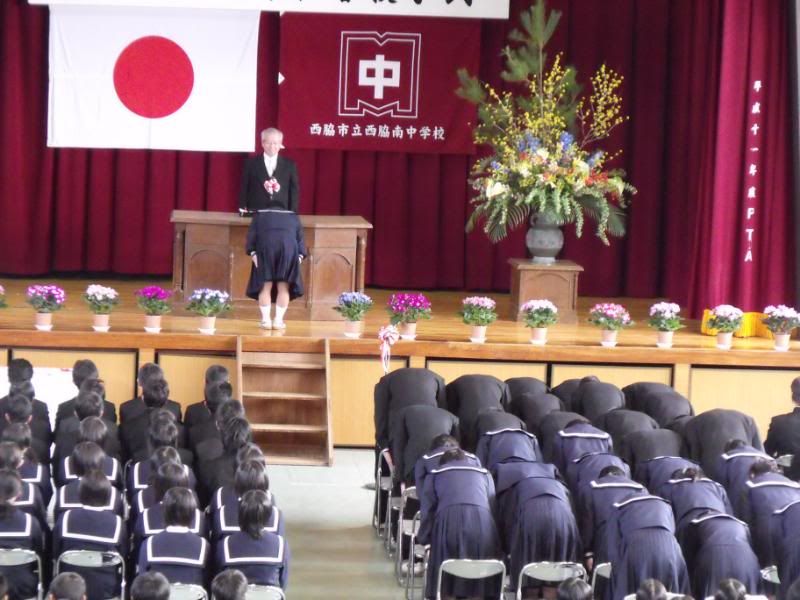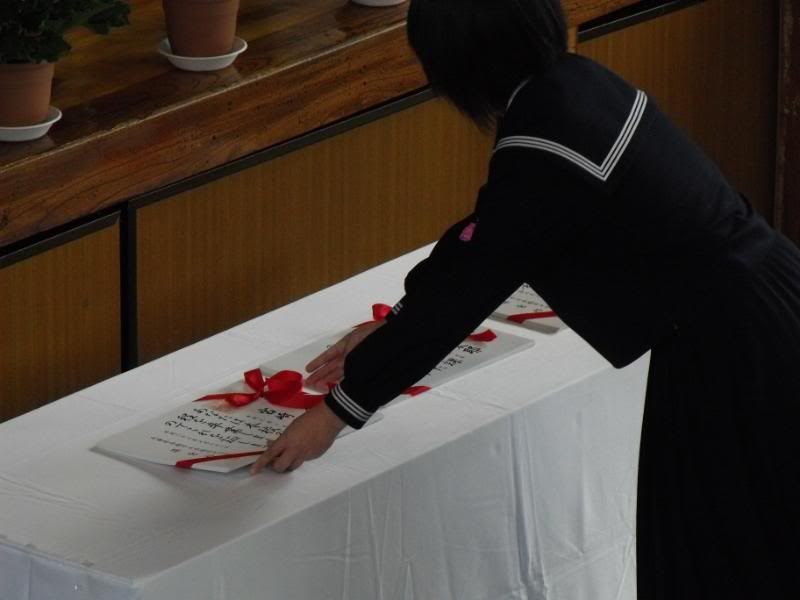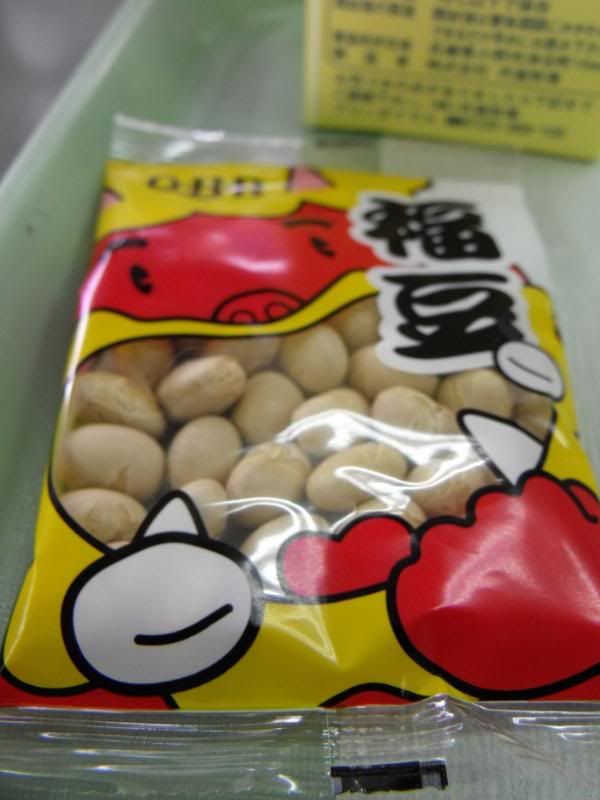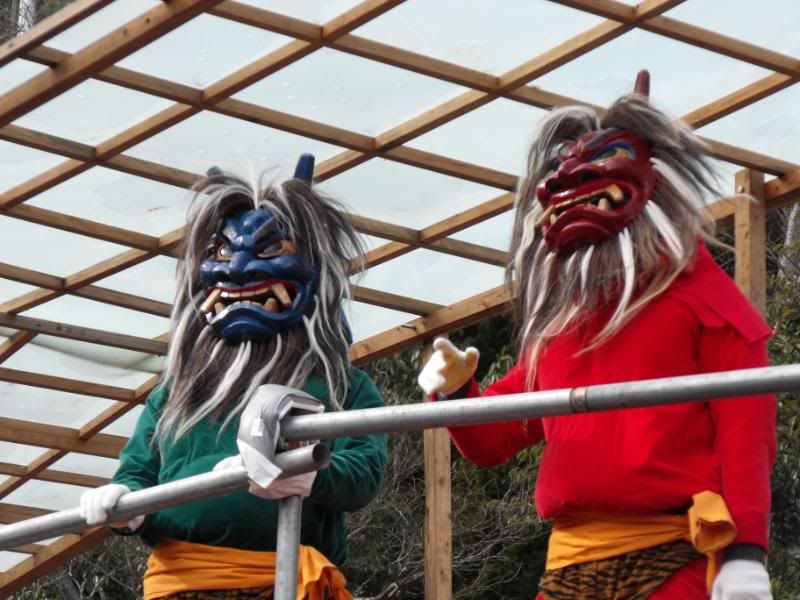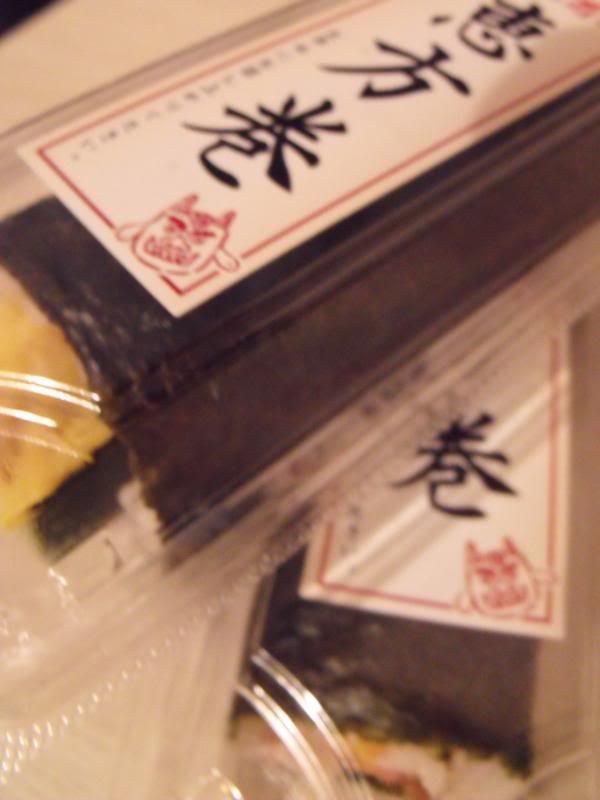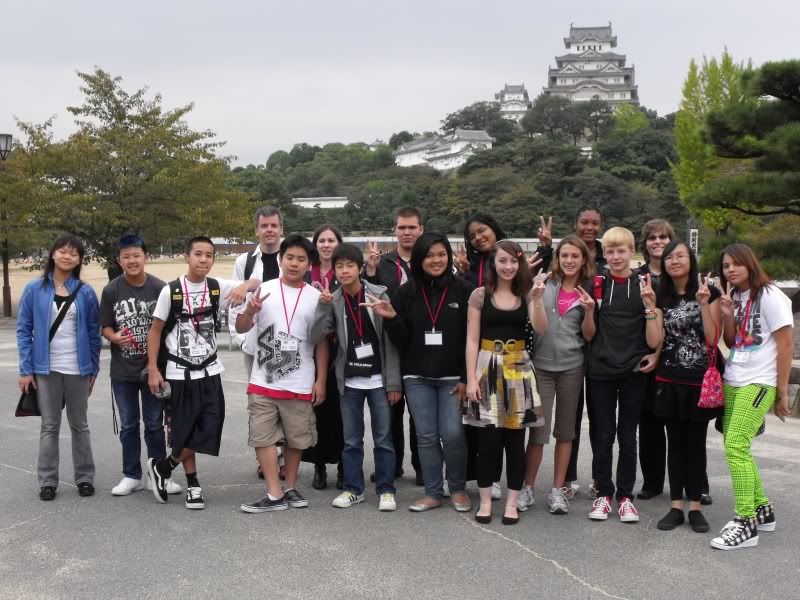It might take a second, but it's pretty funny once you get it.
Wednesday, August 4, 2010
Friday, June 25, 2010
Golden Week Adventure - Part 5
If you ever come to Japan, there are two cities you need to visit: Tokyo, which is the current capital and perfectly represents the ideal of futuristic Japan; and Kyoto, which was the capital before Tokyo and is like walking through a giant museum of ancient Japan. The amount of shrines, temples, gardens and other historic structures in Kyoto could keep you sightseeing non-stop for weeks. Since we were only there for two days, I will definitely be back.
I had a large list of places that I wanted to visit, and on the top of that list was The Golden Pavilion (Kinkakuji), Fushimi Inari Shrine, Gion District and Toei Movie Village. Luckily, we were able to do it all.
But first, since we did spend the night on an overnight bus, we were in need of a stop at our hostel and a shower. I need to spend a few moments gushing over how awesome our hostel was. We stayed at K’s House Kyoto and it was the most beautiful place I have ever spent a night in. The lounge areas were beautifully decorated, comfortable and offered games, travel books and a TV with movies. The shower and bathing areas were so amazing I think a few of us snapped some photos of them. Adjacent to the hostel was a small bar/café that offered a decent breakfast buffet for \600 and cheap drinks and food for night caps. The staff was also super friendly and helpful. They helped us with our luggage, called us a cab when we left, helped us with maps and gave us travelling tips, and they never lost their patience when dealing with less than polite customers. The hostel is also a short walk from Kyoto Station, close to a few gardens and temples, and offers bike rentals. If you’re going to stay in Kyoto I highly, and I mean HIGHLY, recommend this hostel. Just don’t go when I am, I don’t want to have to fight to get a reservation.
Showered and refreshed, we made our way to The Golden Pavilion. It’s called The Golden Pavilion because the two top floors are completely covered in gold leaf and topped with a golden phoenix. The Golden Pavilion is a zen temple that was built in the early 1400’s, but has been burned down and rebuilt numerous times over the years. This current building was built in 1955. It was built overlooking a “reflective pond” that is supposed to help people enjoy the beauty of the temple. In the gardens, you can enjoy other temples, a coin toss, and a food hall where you can try Japanese sweets and matcha which is very bitter green tea.
On our way to The Golden Pavilion from the subway, we passed by Daitokuji Temple, and decided to make a small detour to check out this expansive temple complex. There are so many temples, gardens and well groomed paths that it’s kinda like being in a temple village. Being inside this area, it’s really hard not to feel peaceful and at one with nature. Wow, these old monks knew what they were doing.
After lunch, we headed to Fushimi Inari Shrine. I really wanted to see this shrine because it just looked so beautiful on the travel websites I visited while planning the vacation. Fushimi Inari Shrine is made up of miles of paths that go through a wooded mountain behind the main shrine. Along the paths you walk under thousands of torii gates (the red gates). It’s simply breathtaking. When we got there, it was later in the day so the sun was a little lower and was just barely streaming in through the spaces between the gates. Really, I don’t have the talent necessary to express just how beautiful it all was. I don’t think even Shakespeare had the talent for that. It can take up to two hours to walk through all the trails. Since we were now on day four of our walking-around-tour of Japan, we were pretty beat and didn’t have the energy to complete it. According to a small girl that was walking behind us and counting stairs, we walked well over 1000 stairs, so I’m pretty proud of that.
Besides the thousands of torii gates, Inari Shrine is famous for being a shrine to Inari, the god of rice. It is believed that foxes are his messengers, so throughout the shrine you can see fox statues. There are also numerous food stands throughout the shrine that offer kitsune udon (a soup with fried tofu and thick noodles) which is thought of as the favorite food of these spirit foxes.
To end the day, we decided to head over to Gion for dinner and to hunt down some Geisha. Gion is the place to go if you want to see Geisha. Since it is Golden Week, which should be called “filled with tourists week” the Geisha were in hiding. Other times, if you walk around Gion, you might catch a glimpse of a Geisha or a geisha apprentice walking through the streets. During Golden Week, anyone you see dressed as a Geisha is probably a tourist that has gone to one of the many businesses that will dress you up and take your picture (this is on my list of things to do while in Japan). You can also find tea houses and restaurants where Geisha entertain. These places are ridiculously expansive though. If you really want to see a Geisha, you can head to Gion Corner which holds a daily show, performed by actual geisha apprentices, and is aimed at foreign tourists. You’ll get a taste of the different geisha performances, like dances and a tea ceremony, and it will only cost you about \3150.
Besides Geisha hunting, Gion is just a really neat district to walk around. There is an area that is very modern and filled with expensive items from the latest designers, and then you turn the corner and you’re walking along a narrow street filled with wooden stores that sell Japanese fans, crafts and pickles. It’s quite the contrast that really represents Kyoto well; the new world living in harmony with the old one.
On our last day, we headed to Toei Eigamura, or Movie Village. It’s a theme park and studio. The area has been built to look like feudal Japan. There’s also a power rangers and cartoon museum. Giselle had been there before and said it would only take us about 2 hours to see the whole park. She forgot to take into account that we love cartoons and would play in everything that we could play in. Part of the park has a play area where you can see “movie magic” at work. You can stand in a jail cell with rubber bars, walk around a slanted house, ride a “falling” elevator, and get your x-ray taken, or become part of a giant’s breakfast. Seriously, we’re very silly adults, how are we not going to try all that out?
Then there’s the actual park. We watched a samurai show, took photos of samurai, saw a royal parade, saw a mountain god appear, got water sprayed at us from a lake monster and just had fun playing in all the different buildings. There was a jail, a mansion, and a regular looking house, just to name a few. If you have the money and the time for it, you can also get dressed up. There are expansive studios that dress you up to the nines, and then there’s simple booths were you can put a costume on over your street clothes. I think both of these places also give you the option of walking around in your new outfit. C’mon, how does that not sound like fun?
It was a fun place that I plan on visiting again and it was a good way to end our trip. We had used up all the golden week days and Giselle and I needed to get back to work. All in all, this was a great trip. Would I do it again? No. At least, not like that. But I learned a lot and I think I can make the next trip even better. And next time, I wanna see some monkeys!
I had a large list of places that I wanted to visit, and on the top of that list was The Golden Pavilion (Kinkakuji), Fushimi Inari Shrine, Gion District and Toei Movie Village. Luckily, we were able to do it all.
But first, since we did spend the night on an overnight bus, we were in need of a stop at our hostel and a shower. I need to spend a few moments gushing over how awesome our hostel was. We stayed at K’s House Kyoto and it was the most beautiful place I have ever spent a night in. The lounge areas were beautifully decorated, comfortable and offered games, travel books and a TV with movies. The shower and bathing areas were so amazing I think a few of us snapped some photos of them. Adjacent to the hostel was a small bar/café that offered a decent breakfast buffet for \600 and cheap drinks and food for night caps. The staff was also super friendly and helpful. They helped us with our luggage, called us a cab when we left, helped us with maps and gave us travelling tips, and they never lost their patience when dealing with less than polite customers. The hostel is also a short walk from Kyoto Station, close to a few gardens and temples, and offers bike rentals. If you’re going to stay in Kyoto I highly, and I mean HIGHLY, recommend this hostel. Just don’t go when I am, I don’t want to have to fight to get a reservation.
Showered and refreshed, we made our way to The Golden Pavilion. It’s called The Golden Pavilion because the two top floors are completely covered in gold leaf and topped with a golden phoenix. The Golden Pavilion is a zen temple that was built in the early 1400’s, but has been burned down and rebuilt numerous times over the years. This current building was built in 1955. It was built overlooking a “reflective pond” that is supposed to help people enjoy the beauty of the temple. In the gardens, you can enjoy other temples, a coin toss, and a food hall where you can try Japanese sweets and matcha which is very bitter green tea.
On our way to The Golden Pavilion from the subway, we passed by Daitokuji Temple, and decided to make a small detour to check out this expansive temple complex. There are so many temples, gardens and well groomed paths that it’s kinda like being in a temple village. Being inside this area, it’s really hard not to feel peaceful and at one with nature. Wow, these old monks knew what they were doing.
After lunch, we headed to Fushimi Inari Shrine. I really wanted to see this shrine because it just looked so beautiful on the travel websites I visited while planning the vacation. Fushimi Inari Shrine is made up of miles of paths that go through a wooded mountain behind the main shrine. Along the paths you walk under thousands of torii gates (the red gates). It’s simply breathtaking. When we got there, it was later in the day so the sun was a little lower and was just barely streaming in through the spaces between the gates. Really, I don’t have the talent necessary to express just how beautiful it all was. I don’t think even Shakespeare had the talent for that. It can take up to two hours to walk through all the trails. Since we were now on day four of our walking-around-tour of Japan, we were pretty beat and didn’t have the energy to complete it. According to a small girl that was walking behind us and counting stairs, we walked well over 1000 stairs, so I’m pretty proud of that.
Besides the thousands of torii gates, Inari Shrine is famous for being a shrine to Inari, the god of rice. It is believed that foxes are his messengers, so throughout the shrine you can see fox statues. There are also numerous food stands throughout the shrine that offer kitsune udon (a soup with fried tofu and thick noodles) which is thought of as the favorite food of these spirit foxes.
To end the day, we decided to head over to Gion for dinner and to hunt down some Geisha. Gion is the place to go if you want to see Geisha. Since it is Golden Week, which should be called “filled with tourists week” the Geisha were in hiding. Other times, if you walk around Gion, you might catch a glimpse of a Geisha or a geisha apprentice walking through the streets. During Golden Week, anyone you see dressed as a Geisha is probably a tourist that has gone to one of the many businesses that will dress you up and take your picture (this is on my list of things to do while in Japan). You can also find tea houses and restaurants where Geisha entertain. These places are ridiculously expansive though. If you really want to see a Geisha, you can head to Gion Corner which holds a daily show, performed by actual geisha apprentices, and is aimed at foreign tourists. You’ll get a taste of the different geisha performances, like dances and a tea ceremony, and it will only cost you about \3150.
Besides Geisha hunting, Gion is just a really neat district to walk around. There is an area that is very modern and filled with expensive items from the latest designers, and then you turn the corner and you’re walking along a narrow street filled with wooden stores that sell Japanese fans, crafts and pickles. It’s quite the contrast that really represents Kyoto well; the new world living in harmony with the old one.
On our last day, we headed to Toei Eigamura, or Movie Village. It’s a theme park and studio. The area has been built to look like feudal Japan. There’s also a power rangers and cartoon museum. Giselle had been there before and said it would only take us about 2 hours to see the whole park. She forgot to take into account that we love cartoons and would play in everything that we could play in. Part of the park has a play area where you can see “movie magic” at work. You can stand in a jail cell with rubber bars, walk around a slanted house, ride a “falling” elevator, and get your x-ray taken, or become part of a giant’s breakfast. Seriously, we’re very silly adults, how are we not going to try all that out?
Then there’s the actual park. We watched a samurai show, took photos of samurai, saw a royal parade, saw a mountain god appear, got water sprayed at us from a lake monster and just had fun playing in all the different buildings. There was a jail, a mansion, and a regular looking house, just to name a few. If you have the money and the time for it, you can also get dressed up. There are expansive studios that dress you up to the nines, and then there’s simple booths were you can put a costume on over your street clothes. I think both of these places also give you the option of walking around in your new outfit. C’mon, how does that not sound like fun?
It was a fun place that I plan on visiting again and it was a good way to end our trip. We had used up all the golden week days and Giselle and I needed to get back to work. All in all, this was a great trip. Would I do it again? No. At least, not like that. But I learned a lot and I think I can make the next trip even better. And next time, I wanna see some monkeys!
Labels:
holidays,
Japanese culture,
shrines,
Sightseeing
Golden Week Adventure - Part 4
Because I’m crazy, I agreed with my trip planning partner in crime, Giselle, that we should spend a day going to some of the tourist attractions outside of Tokyo. We decided on Yokohama and Kamakura.
Yokohama is less than a half hour away from Tokyo by train and is Japan’s second largest city. Since it is a harbor town, it was one of the first ports that opened up to foreigners and was Japan’s gateway to the western world during the Meiji Era. It also has some great tourists spots, including the world’s largest Chinatown (outside of China), a beer factory with guided tours that include free samples at the end, and a ramen museum built to look like a Japanese market street from the 1950’s.
Kamakura is a much smaller town that is located only a few minutes from Yokohama. It is a very ancient city filled with shrines, temples and the Japan’s second-largest Buddha statue (don’t ask me why, but I have this thing for checking out overly large statues). The shrine that really appealed to me was Zeniarai Benten, a shrine located inside a cave where, according to legend, if you wash your money there it will double.
Unfortunately, we would not get the chance to see any of this. Well, all most all of it. Remember how I said that Golden Week is the busiest travel time in Japan? This day we learned just how true that was.
The plan was to go to Yokohama Station and leave our suitcases in one of the large coin lockers and then continue on our adventures. At the end of the day, we would be taking an overnight bus from Yokohama Station to Kyoto, so this seemed like a simple plan that would make our trip easy and worry free.
First snag in the plan: when we got to Yokohama Station, there were no lockers left. Okay, no worries, we can adapt. We decided to take our bags to Kamakura and leave them in the station there. Once again, no lockers. We asked around and found out that a bike rental shop beside the station had cleared out all their bikes and were using the empty lot to hold luggage for weary travelers such as us. But there was a catch; you had to pick up your bags by 4pm. We had spent so much time running around looking for lockers and being squished on trains, and we ended up on the wrong train at one point, that it was already 2pm. Okay, we wouldn’t have time to do everything, but maybe we could still check out the giant Buddha statue. Nope. Kamakura was so busy that it would take over an hour to get there by any mode of transportation because of the long line ups. But, if we wanted, we could try walking there. It would take about 30 minutes. We decided to walk. We got lost. We ended up just hanging out on the beach and enjoying the ocean.
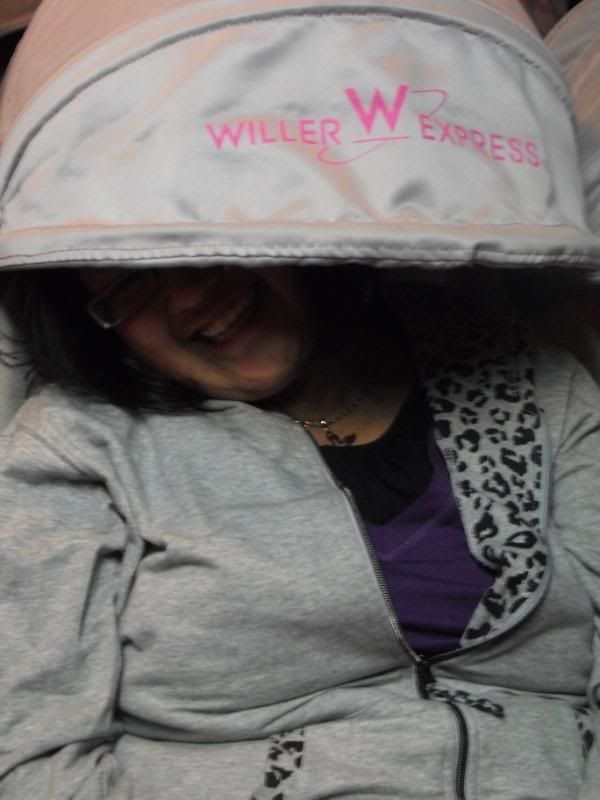 It definitely wasn’t how I had hoped the day would go. Did I learn a lesson from all of this? Oh yeah. Never plan so much in one day, and don’t try to travel long distances during Golden Week. Those trains were packed beyond packed. The Japanese may be a really polite group of people, but all of that goes out the window when they’re trying to get on a train. They will push and shove as if the other people on the train were made out of play-doh.
It definitely wasn’t how I had hoped the day would go. Did I learn a lesson from all of this? Oh yeah. Never plan so much in one day, and don’t try to travel long distances during Golden Week. Those trains were packed beyond packed. The Japanese may be a really polite group of people, but all of that goes out the window when they’re trying to get on a train. They will push and shove as if the other people on the train were made out of play-doh.
But the day wasn’t completely lost. Once we returned to Yokohama, we were able to find lockers for our suitcases and explore Chinatown. We ate some amazing food, watched a few lion dances complete with firecrackers, and did some shopping. I don’t know if all that made up for the day we had, but it definitely made it better.
At the end of the day, we found our luxurious overnight bus. We tucked ourselves into our seats, wrapped ourselves into our blankets, and pulled down the “cone of silence.” It was a really comfortable and interesting sleep that lasted until we arrived in Kyoto.
Yokohama is less than a half hour away from Tokyo by train and is Japan’s second largest city. Since it is a harbor town, it was one of the first ports that opened up to foreigners and was Japan’s gateway to the western world during the Meiji Era. It also has some great tourists spots, including the world’s largest Chinatown (outside of China), a beer factory with guided tours that include free samples at the end, and a ramen museum built to look like a Japanese market street from the 1950’s.
Kamakura is a much smaller town that is located only a few minutes from Yokohama. It is a very ancient city filled with shrines, temples and the Japan’s second-largest Buddha statue (don’t ask me why, but I have this thing for checking out overly large statues). The shrine that really appealed to me was Zeniarai Benten, a shrine located inside a cave where, according to legend, if you wash your money there it will double.
Unfortunately, we would not get the chance to see any of this. Well, all most all of it. Remember how I said that Golden Week is the busiest travel time in Japan? This day we learned just how true that was.
The plan was to go to Yokohama Station and leave our suitcases in one of the large coin lockers and then continue on our adventures. At the end of the day, we would be taking an overnight bus from Yokohama Station to Kyoto, so this seemed like a simple plan that would make our trip easy and worry free.
First snag in the plan: when we got to Yokohama Station, there were no lockers left. Okay, no worries, we can adapt. We decided to take our bags to Kamakura and leave them in the station there. Once again, no lockers. We asked around and found out that a bike rental shop beside the station had cleared out all their bikes and were using the empty lot to hold luggage for weary travelers such as us. But there was a catch; you had to pick up your bags by 4pm. We had spent so much time running around looking for lockers and being squished on trains, and we ended up on the wrong train at one point, that it was already 2pm. Okay, we wouldn’t have time to do everything, but maybe we could still check out the giant Buddha statue. Nope. Kamakura was so busy that it would take over an hour to get there by any mode of transportation because of the long line ups. But, if we wanted, we could try walking there. It would take about 30 minutes. We decided to walk. We got lost. We ended up just hanging out on the beach and enjoying the ocean.
 It definitely wasn’t how I had hoped the day would go. Did I learn a lesson from all of this? Oh yeah. Never plan so much in one day, and don’t try to travel long distances during Golden Week. Those trains were packed beyond packed. The Japanese may be a really polite group of people, but all of that goes out the window when they’re trying to get on a train. They will push and shove as if the other people on the train were made out of play-doh.
It definitely wasn’t how I had hoped the day would go. Did I learn a lesson from all of this? Oh yeah. Never plan so much in one day, and don’t try to travel long distances during Golden Week. Those trains were packed beyond packed. The Japanese may be a really polite group of people, but all of that goes out the window when they’re trying to get on a train. They will push and shove as if the other people on the train were made out of play-doh.But the day wasn’t completely lost. Once we returned to Yokohama, we were able to find lockers for our suitcases and explore Chinatown. We ate some amazing food, watched a few lion dances complete with firecrackers, and did some shopping. I don’t know if all that made up for the day we had, but it definitely made it better.
At the end of the day, we found our luxurious overnight bus. We tucked ourselves into our seats, wrapped ourselves into our blankets, and pulled down the “cone of silence.” It was a really comfortable and interesting sleep that lasted until we arrived in Kyoto.
Labels:
holidays,
Japanese culture,
Life in Japan,
Sightseeing
Monday, June 14, 2010
Golden Week Adventure - Part 3
Tokyo is big. No, I mean Tokyo is really, really big. Tokyo is so big, I’m pretty sure that it’s considered its own prefecture. Yeah, it’s so big it’s a city and a prefecture. It’s so big I don’t even fully comprehend it. Now that I’ve been there, I understand it a bit better, but I still don’t understand it.
Tokyo is big. Tokyo is so big, if you want to go there, you need to pick one or two wards or areas to go see a day and just stick with that. Maybe you can have a third place in mind as a back-up plan, but don’t try to be a hero. Tokyo is big and there’s a lot to see, so take your time.
For our second day, we had a plan that was pretty packed. First, we were off to Harajuku. Harajuku is another area of Tokyo that is popular amongst the young folk. It’s where you go if you want to buy clothes to look like a Goth, cos-player or if you’re like me and can’t survive without some sort of outfit that includes cat ears (if you’re not a cat fan bear, dog and rabbit eared outfits are also available). You can also find posh stores like Louis Vuitton, but they’re not very interesting to me.
The stores that I am interested in are all located on Takeshita Dori, a very narrow street lined with funky clothing shops, shops filled with nothing by posters of Japanese celebrities, cafes, and one of the largest Daiso’s (a Japanese dollar stores) in Tokyo.
This is all well and good, if you can get into the street. Actually getting into the street wasn’t the problem, navigating my way through the street was the problem. This is what I get for trying to go to such a popular spot on a Sunday during golden week. The street was packed! Tokyo stereotype packed. I’m surprised that my friends and I were able to find each other whenever we parted ways. It was just crazy. Oh yeah, I plan on going again. But this time maybe a Tuesday morning.
Ah, but why did we go to Harajuku on a Sunday? Sunday is the day when all the kids are out and about in their funky outfits. We saw a few Gothic Lolita girls (sorry, it was too crowded to try and get a picture), a few cos-players, and a few Goths. A few people were willing to let the gawking foreigners take their pictures, but a lot of them were against it, which I find kinda funny. If you’re going to go through all the trouble to look like that, then why not let people take your picture. You must be dressing like that for some kind of attention, right?
Now if everything I talked about sounds boring or immature for you, oh one of such impeccable tastes, you may want to visit Harajuku for Meiji Shrine. Meiji Shrine is a Shinto shrine dedicated to “the deified spirits of Emperor Meiji and Empress Shoken.” Emperor Meiji was emperor in the late 1800’s. He was a pretty great emperor who did a lot of things that shaped Japan into the country it is today. For example, he was responsible for making Japan modern and westernized, and for bringing democracy to the country. No wonder he was deified and got his own shrine.
The shrine itself was completed in 1920, but rebuilt after it was destroyed in WW2. I don’t know if you can tell from the pictures, but the torii gate that acts as the entrance to Meiji Shrine is huge! And according to plaques on the torii gate, these are the original torii gates. Meaning they’ve been standing there for almost 100 years. I guess coming from such a young country, it’s hard to imagine anything that old still existing.
Having explored Harajuku to the point of exhaustion, we decided to make our way to Shibuya. Shibuya is another youthful place in Tokyo filled with trendy fashion, but the fashion here is much more upscale.
Now anyone who knows me knows that I really don’t care about fashion. And I don’t. Give me a plain solid color tee with a pair of jeans any day. Oh, and maybe a kitty hat to go with it. That’s as far as my fashion sense goes. But Shibuya is Japan’s Times Square, it’s just one of those places you have to see. Also, Shibuya was the main location for one of my favorite animes, Super Gals, so I had to go experience it for myself.
We got our first glance of Shibuya from a window inside the station. Seeing all the tall buildings and department stores was pretty amazing. And then the traffic lights changed and our world was changed forever. When the lights at this crosswalk change, they allow people to cross in six different directions at once. I don’t remember how long the lights stay green for, but the amount of people that crossed there was staggering. It was a seemingly never-ending stream of people crossing the street. They seemed to come out of nowhere and I have no idea where they went. It was like they disappeared once they finished crossing. Watching the people below do something as simple as cross the street was amazing, scary (because I knew at some point I would be among that throng of people) and just really, really cool. It gave me one of those “wow, I’m in Japan” moments.
Outside of Shibuya station there is a statue of a dog. The dog’s name is Hachiko. According to tales, Hachi used to wait outside of Shibuya station everyday for his master. One day, his master passed away before he made it to Shibuya station, but Hachiko still waited. He waited and waited until he finally passed away. And thus, there’s now a statue of him. There’s more to the story so if you want to find out more you can check out the movie, Hachi, starring Richard Gere. Seeing Hachiko was high on my list of “Things I have to do in Japan,” so I was thrilled when I got to take a photo with the famous statue. That’s one thing checked off of a very long list.
The rest of time is Shibuya was spent looking around fancy and trendy shops and acting like yokels who’ve never seen tall buildings before. We also had a quick stop in a McDonald’s. I realize that doesn’t seem very exciting, but this was the fanciest McDonald’s I’ve ever been to. Everything was a little bit more expensive (they didn’t have a dollar menu) but considering the service you get, it was worth the extra 50 yen. After we got our order, we headed downstairs (many McDonald’s have multiple floors) to find a table. When we got there a hostess took our tray and found us a table in the cramped space, passed the trendy teenagers and empty tables with reservation signs. At our table we found a laminated menu card, much like the kind you would find at fancier restaurants. After we finished our food, someone came and took our tray threw away our garbage for us. We left quickly after that since the place was packed and we felt bad taking up such precious real-estate. I also felt bad taking pictures in there, so I only snapped a quick one of the inside of the dining area. Maybe next time I’ll have the courage to try and get a picture of an employee in their cute outfit that included a skirt and pastel colored beret.
Last stop on day two of our adventure was Akihabara. Unfortunately we got there really late, so majority of the shops were closed, but we still enjoyed what we found. I wanted to get purikura (picture stickers) with everyone, so we headed to Club Sega, a multi-leveled arcade and amusement centre. Well, first we got lost and got directions from an employee of a different Club Sega dressed in school girl cos-play. The purikura area here was pretty interesting. They had costumes you could wear while taking your pictures, and areas with scissors so you could cut out your page of stickers and divide them amongst your group. After we got our pictures, we headed to the arcade. Kris amused himself at the drumming game, as usual, and Giselle and Scott tried out a Tetris game with a giant arcade stick. I think they even vibrated.
Our quick trip to Akihabara was the perfect end to a very long day. We hopped on the last train back to our hostel and passed out.
Tokyo is big. Tokyo is so big, if you want to go there, you need to pick one or two wards or areas to go see a day and just stick with that. Maybe you can have a third place in mind as a back-up plan, but don’t try to be a hero. Tokyo is big and there’s a lot to see, so take your time.
For our second day, we had a plan that was pretty packed. First, we were off to Harajuku. Harajuku is another area of Tokyo that is popular amongst the young folk. It’s where you go if you want to buy clothes to look like a Goth, cos-player or if you’re like me and can’t survive without some sort of outfit that includes cat ears (if you’re not a cat fan bear, dog and rabbit eared outfits are also available). You can also find posh stores like Louis Vuitton, but they’re not very interesting to me.
The stores that I am interested in are all located on Takeshita Dori, a very narrow street lined with funky clothing shops, shops filled with nothing by posters of Japanese celebrities, cafes, and one of the largest Daiso’s (a Japanese dollar stores) in Tokyo.
This is all well and good, if you can get into the street. Actually getting into the street wasn’t the problem, navigating my way through the street was the problem. This is what I get for trying to go to such a popular spot on a Sunday during golden week. The street was packed! Tokyo stereotype packed. I’m surprised that my friends and I were able to find each other whenever we parted ways. It was just crazy. Oh yeah, I plan on going again. But this time maybe a Tuesday morning.
Ah, but why did we go to Harajuku on a Sunday? Sunday is the day when all the kids are out and about in their funky outfits. We saw a few Gothic Lolita girls (sorry, it was too crowded to try and get a picture), a few cos-players, and a few Goths. A few people were willing to let the gawking foreigners take their pictures, but a lot of them were against it, which I find kinda funny. If you’re going to go through all the trouble to look like that, then why not let people take your picture. You must be dressing like that for some kind of attention, right?
Now if everything I talked about sounds boring or immature for you, oh one of such impeccable tastes, you may want to visit Harajuku for Meiji Shrine. Meiji Shrine is a Shinto shrine dedicated to “the deified spirits of Emperor Meiji and Empress Shoken.” Emperor Meiji was emperor in the late 1800’s. He was a pretty great emperor who did a lot of things that shaped Japan into the country it is today. For example, he was responsible for making Japan modern and westernized, and for bringing democracy to the country. No wonder he was deified and got his own shrine.
The shrine itself was completed in 1920, but rebuilt after it was destroyed in WW2. I don’t know if you can tell from the pictures, but the torii gate that acts as the entrance to Meiji Shrine is huge! And according to plaques on the torii gate, these are the original torii gates. Meaning they’ve been standing there for almost 100 years. I guess coming from such a young country, it’s hard to imagine anything that old still existing.
Having explored Harajuku to the point of exhaustion, we decided to make our way to Shibuya. Shibuya is another youthful place in Tokyo filled with trendy fashion, but the fashion here is much more upscale.
Now anyone who knows me knows that I really don’t care about fashion. And I don’t. Give me a plain solid color tee with a pair of jeans any day. Oh, and maybe a kitty hat to go with it. That’s as far as my fashion sense goes. But Shibuya is Japan’s Times Square, it’s just one of those places you have to see. Also, Shibuya was the main location for one of my favorite animes, Super Gals, so I had to go experience it for myself.
We got our first glance of Shibuya from a window inside the station. Seeing all the tall buildings and department stores was pretty amazing. And then the traffic lights changed and our world was changed forever. When the lights at this crosswalk change, they allow people to cross in six different directions at once. I don’t remember how long the lights stay green for, but the amount of people that crossed there was staggering. It was a seemingly never-ending stream of people crossing the street. They seemed to come out of nowhere and I have no idea where they went. It was like they disappeared once they finished crossing. Watching the people below do something as simple as cross the street was amazing, scary (because I knew at some point I would be among that throng of people) and just really, really cool. It gave me one of those “wow, I’m in Japan” moments.
Outside of Shibuya station there is a statue of a dog. The dog’s name is Hachiko. According to tales, Hachi used to wait outside of Shibuya station everyday for his master. One day, his master passed away before he made it to Shibuya station, but Hachiko still waited. He waited and waited until he finally passed away. And thus, there’s now a statue of him. There’s more to the story so if you want to find out more you can check out the movie, Hachi, starring Richard Gere. Seeing Hachiko was high on my list of “Things I have to do in Japan,” so I was thrilled when I got to take a photo with the famous statue. That’s one thing checked off of a very long list.
The rest of time is Shibuya was spent looking around fancy and trendy shops and acting like yokels who’ve never seen tall buildings before. We also had a quick stop in a McDonald’s. I realize that doesn’t seem very exciting, but this was the fanciest McDonald’s I’ve ever been to. Everything was a little bit more expensive (they didn’t have a dollar menu) but considering the service you get, it was worth the extra 50 yen. After we got our order, we headed downstairs (many McDonald’s have multiple floors) to find a table. When we got there a hostess took our tray and found us a table in the cramped space, passed the trendy teenagers and empty tables with reservation signs. At our table we found a laminated menu card, much like the kind you would find at fancier restaurants. After we finished our food, someone came and took our tray threw away our garbage for us. We left quickly after that since the place was packed and we felt bad taking up such precious real-estate. I also felt bad taking pictures in there, so I only snapped a quick one of the inside of the dining area. Maybe next time I’ll have the courage to try and get a picture of an employee in their cute outfit that included a skirt and pastel colored beret.
Last stop on day two of our adventure was Akihabara. Unfortunately we got there really late, so majority of the shops were closed, but we still enjoyed what we found. I wanted to get purikura (picture stickers) with everyone, so we headed to Club Sega, a multi-leveled arcade and amusement centre. Well, first we got lost and got directions from an employee of a different Club Sega dressed in school girl cos-play. The purikura area here was pretty interesting. They had costumes you could wear while taking your pictures, and areas with scissors so you could cut out your page of stickers and divide them amongst your group. After we got our pictures, we headed to the arcade. Kris amused himself at the drumming game, as usual, and Giselle and Scott tried out a Tetris game with a giant arcade stick. I think they even vibrated.
Our quick trip to Akihabara was the perfect end to a very long day. We hopped on the last train back to our hostel and passed out.
Wednesday, June 9, 2010
Golden Week Adventures - Part 2
Okay, now where was I… oh right, we were exploring Akiba. Well more, Kris was exploring, and I was running out the clock until I had to hop on a train to go pick up my first visitor, my buddy Scott.
Like I said earlier, our hostel was in Asakusa, which, according to the Tokyo transit map, is the last stop in Metro Tokyo before Narita Airport. What they don’t tell you is just how much things have been scaled down to fit everything onto this map. Therefore, what looked like only a 15 min subway ride was actually an hour long trip outside of Tokyo and into the Japanese countryside. So much for being early and looking at souvenirs…
And to make matters worse, I was held back at the train gate over some misinformation about the cost to the airport. Then I got totally lost. This left Scott lost and alone in the airport for about an hour. But we found each other, and we made our way back to the hostel.
Our travel group now complete, we headed to Roppongi to have dinner at The Hard Rock Café (I know, so Japanese, right?) and to see Tokyo Tower. Tokyo Tower is very pretty at night, all lit up with lights that really just makes the skyline of Roppongi breathtaking, but, up close, it’s not as impressive. Or, maybe it’s just not as impressive to a group that has been inside The CN Tower which is almost twice the height of Tokyo Tower. I guess in a couple of years we'll have to go visit Tokyo Sky Tree, which is already taller than Tokyo Tower and it still has 18 months worth of building to be completed.
Roppongi is a pretty interesting area of Tokyo. It’s another area of Tokyo that is very popular with “the young folks” and it’s easy to see why. The streets are lined with clubs, pubs, and numerous American restaurants. If you’re looking for the Tokyo nightlife, Roppongi is the place to go.
A warning: if you’re a blond boy, like my buddy Scott, you’re going to get harassed by Samoan club owners looking to fill their clubs with blondes in order to attract Japanese women. It was pretty bad. Within the span of a block, Scott was approached by four different men all trying to convenience him to go to their club. As soon as one man left, another one swooped in to take his place. Even if you’re not blonde, you could be approached by club owners just trying to fill their clubs. Only these ones won’t follow you as you walk away.
Hey, look at that, I finished day one! Next time… day two!
Like I said earlier, our hostel was in Asakusa, which, according to the Tokyo transit map, is the last stop in Metro Tokyo before Narita Airport. What they don’t tell you is just how much things have been scaled down to fit everything onto this map. Therefore, what looked like only a 15 min subway ride was actually an hour long trip outside of Tokyo and into the Japanese countryside. So much for being early and looking at souvenirs…
And to make matters worse, I was held back at the train gate over some misinformation about the cost to the airport. Then I got totally lost. This left Scott lost and alone in the airport for about an hour. But we found each other, and we made our way back to the hostel.
Our travel group now complete, we headed to Roppongi to have dinner at The Hard Rock Café (I know, so Japanese, right?) and to see Tokyo Tower. Tokyo Tower is very pretty at night, all lit up with lights that really just makes the skyline of Roppongi breathtaking, but, up close, it’s not as impressive. Or, maybe it’s just not as impressive to a group that has been inside The CN Tower which is almost twice the height of Tokyo Tower. I guess in a couple of years we'll have to go visit Tokyo Sky Tree, which is already taller than Tokyo Tower and it still has 18 months worth of building to be completed.
Roppongi is a pretty interesting area of Tokyo. It’s another area of Tokyo that is very popular with “the young folks” and it’s easy to see why. The streets are lined with clubs, pubs, and numerous American restaurants. If you’re looking for the Tokyo nightlife, Roppongi is the place to go.
A warning: if you’re a blond boy, like my buddy Scott, you’re going to get harassed by Samoan club owners looking to fill their clubs with blondes in order to attract Japanese women. It was pretty bad. Within the span of a block, Scott was approached by four different men all trying to convenience him to go to their club. As soon as one man left, another one swooped in to take his place. Even if you’re not blonde, you could be approached by club owners just trying to fill their clubs. Only these ones won’t follow you as you walk away.
Hey, look at that, I finished day one! Next time… day two!
Friday, June 4, 2010
Golden Week Adventures - Part 1
Sorry about the delay lately, folks. But your favorite stranger in a strange land is back and ready to talk of adventure.
One of the reasons for the radio silence of late was that I was busy planning a major vacation for my first golden week in Japan. One of the reasons why I was making this trip so spectacular was because I got my first visitor from the homeland and I wanted to make sure that his first, and probably only, trip to Japan would be memorable and action packed. While it was as action-packed as I had hoped, I didn’t think it would be so crazy, but we’ll get to that later. For now, let’s just say I learned a lot from this trip. A lot about Japan, a lot about myself and my friends, and a lot about how a sardine feels.
Moving on… Golden Week is a wonderful time between April 29 and May 5 that includes 4 days off and, when mixed with a weekend, gives the average employee seven days off. This is one of the things in Japan that would never happen in North America. Since almost everyone in the country has so many days off, it’s the busiest travel season of the year. And after touring a good chunk of the country, I can definitely say that that is one of the most factual statements on this blog.
After weeks of trolling Japan travel websites, reserving hostels and transportation, and triple checking everything, the big date had finally arrived! On April 30, after school was done, Kris and I grabbed our bags, locked up our apartment and headed to the train station, about to start on our grand adventure.
There are a lot of ways to get across the country; the very reliable JR train, the super speedy bullet train (or Shinkansen), highway buses and overnight buses, or by airplane. For this part of the trip, we opted for an overnight bus. Now, as a North American, I know what kind of images the term “overnight bus” or even “highway bus” brings to mind. But, like most things in Japan, it’s not the same here. While overnight buses are a much more affordable way to travel, they aren’t nearly as dingy, dirty or disgusting as their North American counterparts. They’re very well maintained, modern, and, in some cases, incredibly comfy. The bus we took from Kobe to Tokyo, wasn’t the incredibly comfy kind (we cheaped out on this ride) but the one we took from Tokyo to Kyoto was like a cloud, complete with a cone of silence.
The next morning, we found ourselves in the very large and busy Tokyo Station. This was our second time in Tokyo Station and, if I can help it, our last. Tokyo Station seems to be in a constant state of construction and is very hard to navigate through. I think we were lost for about an hour trying to find our way to the Tokyo subway station that would eventually take us to our hostel.
Ah, there’s another word that would make a normal North American squirm. While this hostel does have rooms that hold eight or so people, they also have nice and clean private rooms that can hold one to four people. We stayed in a private room that held the four of us. It had bunk beds, which is a lot of fun for me, because I have the maturity of a five year old. While the hostel in Tokyo was nice, the hostel in Kyoto was amazing, but we’ll get to that later.
Our hostel was in an area of Tokyo called Asakusa. It’s a very old area of Tokyo, but a very beautiful area. Asakusa hosts an area with a few temples, shrines, old fashioned market and an old amusement park. This area is also famous for making and selling plastic food. Almost every restaurant in Japan has displays outside of it that shows the food you can order. The displays are pretty amazing. They look real enough to eat, and it seems like you can get anything in plastic form. And this is where they get it from. I didn’t get a chance to look at the shops, but there’s always next time. As it was, we didn’t have enough time to explore the area with the temples and shrines as much as we would have liked. But we did get some nice pictures, and I got some great ideas for presents for family and friends.
After we checked in and got our bags safely stored away, we headed to Tsukiji Fish Market. This is Japan’s largest and busiest fish market. The market comes to life at about 5 am. At around 6 am, the tuna market opens up. This is a big tourist attraction. Unfortunately, it was closed during Golden Week, and, thanks to our adventures in Tokyo Station, we would have been too late for it anyways. It was pretty cool to see. Even though there were a bunch of tourists, business never stopped. Men were packing fish in ice, conducting business and just going on as if they weren’t being stared at from on-lookers. Another reason to head to the fish market is to check out the different shops and the restaurants that serve the freshest raw fish you’ve ever had. There’s nothing like a raw tuna over rice for breakfast. Yum! But what really stuck out to me about the fish market is that there weren’t any stray cats in the area, which is pretty impressive considering that the fish smell is so strong that you can smell it while you’re still in the subway.
Having finished our adventures in the fish market, we headed to Akihabara. Akihabara is Tokyo’s anime and electronic district. This is where you go if you want to find the crazy anime and manga toys, play a bunch of video games, and find the crazy electronics that Japan is known for. This is the only part of the trip that Kris really cared about. Since he didn’t get enough time to really experience Akihabara this trip, next time we head to Tokyo, I’m just gonna leave him there and meet up with him again for dinner. Like a daycare…
Wow that's a lot, and we're not even finished the first day. Okay, I'm going to go take a break and I'll be back with the next chapter next week!
One of the reasons for the radio silence of late was that I was busy planning a major vacation for my first golden week in Japan. One of the reasons why I was making this trip so spectacular was because I got my first visitor from the homeland and I wanted to make sure that his first, and probably only, trip to Japan would be memorable and action packed. While it was as action-packed as I had hoped, I didn’t think it would be so crazy, but we’ll get to that later. For now, let’s just say I learned a lot from this trip. A lot about Japan, a lot about myself and my friends, and a lot about how a sardine feels.
Moving on… Golden Week is a wonderful time between April 29 and May 5 that includes 4 days off and, when mixed with a weekend, gives the average employee seven days off. This is one of the things in Japan that would never happen in North America. Since almost everyone in the country has so many days off, it’s the busiest travel season of the year. And after touring a good chunk of the country, I can definitely say that that is one of the most factual statements on this blog.
After weeks of trolling Japan travel websites, reserving hostels and transportation, and triple checking everything, the big date had finally arrived! On April 30, after school was done, Kris and I grabbed our bags, locked up our apartment and headed to the train station, about to start on our grand adventure.
There are a lot of ways to get across the country; the very reliable JR train, the super speedy bullet train (or Shinkansen), highway buses and overnight buses, or by airplane. For this part of the trip, we opted for an overnight bus. Now, as a North American, I know what kind of images the term “overnight bus” or even “highway bus” brings to mind. But, like most things in Japan, it’s not the same here. While overnight buses are a much more affordable way to travel, they aren’t nearly as dingy, dirty or disgusting as their North American counterparts. They’re very well maintained, modern, and, in some cases, incredibly comfy. The bus we took from Kobe to Tokyo, wasn’t the incredibly comfy kind (we cheaped out on this ride) but the one we took from Tokyo to Kyoto was like a cloud, complete with a cone of silence.
The next morning, we found ourselves in the very large and busy Tokyo Station. This was our second time in Tokyo Station and, if I can help it, our last. Tokyo Station seems to be in a constant state of construction and is very hard to navigate through. I think we were lost for about an hour trying to find our way to the Tokyo subway station that would eventually take us to our hostel.
Ah, there’s another word that would make a normal North American squirm. While this hostel does have rooms that hold eight or so people, they also have nice and clean private rooms that can hold one to four people. We stayed in a private room that held the four of us. It had bunk beds, which is a lot of fun for me, because I have the maturity of a five year old. While the hostel in Tokyo was nice, the hostel in Kyoto was amazing, but we’ll get to that later.
Our hostel was in an area of Tokyo called Asakusa. It’s a very old area of Tokyo, but a very beautiful area. Asakusa hosts an area with a few temples, shrines, old fashioned market and an old amusement park. This area is also famous for making and selling plastic food. Almost every restaurant in Japan has displays outside of it that shows the food you can order. The displays are pretty amazing. They look real enough to eat, and it seems like you can get anything in plastic form. And this is where they get it from. I didn’t get a chance to look at the shops, but there’s always next time. As it was, we didn’t have enough time to explore the area with the temples and shrines as much as we would have liked. But we did get some nice pictures, and I got some great ideas for presents for family and friends.
After we checked in and got our bags safely stored away, we headed to Tsukiji Fish Market. This is Japan’s largest and busiest fish market. The market comes to life at about 5 am. At around 6 am, the tuna market opens up. This is a big tourist attraction. Unfortunately, it was closed during Golden Week, and, thanks to our adventures in Tokyo Station, we would have been too late for it anyways. It was pretty cool to see. Even though there were a bunch of tourists, business never stopped. Men were packing fish in ice, conducting business and just going on as if they weren’t being stared at from on-lookers. Another reason to head to the fish market is to check out the different shops and the restaurants that serve the freshest raw fish you’ve ever had. There’s nothing like a raw tuna over rice for breakfast. Yum! But what really stuck out to me about the fish market is that there weren’t any stray cats in the area, which is pretty impressive considering that the fish smell is so strong that you can smell it while you’re still in the subway.
Having finished our adventures in the fish market, we headed to Akihabara. Akihabara is Tokyo’s anime and electronic district. This is where you go if you want to find the crazy anime and manga toys, play a bunch of video games, and find the crazy electronics that Japan is known for. This is the only part of the trip that Kris really cared about. Since he didn’t get enough time to really experience Akihabara this trip, next time we head to Tokyo, I’m just gonna leave him there and meet up with him again for dinner. Like a daycare…
Wow that's a lot, and we're not even finished the first day. Okay, I'm going to go take a break and I'll be back with the next chapter next week!
Wednesday, April 7, 2010
Beginnings
Spring brings more to Japan than just pretty colored trees. Spring also marks the beginning of a new school year. While all around us nature is refreshing and beginning anew, so is our school. I kinda like that. Spring has always been used as a metaphor for beginnings, so having the new school year start in the spring makes sense. With the long break in the summer, it doesn’t necessarily work as well as having the school year start after the long break, but it still makes sense.
Now, for many, a new school year doesn’t mean much more than just a return to the same schedule after a short break. For others, like the 7 new teachers and 161 new students that just entered my junior high school, it means a brand new life. And in the case of the students,that includes 2 brand new uniforms, brand new gym clothes, a brand new school bag (which is an official school duffel bag and a complete change from the hard and sturdy backpacks they used for the last 6 years), 2 brand new pairs of shoes, and, of course, new teachers and new classmates.
Oddly enough, at least to me, beginning your time at a new school is so important that there’s a big entrance ceremony to commemorate the occasion. While it was rehearsed less than the graduation ceremony, it seemed to be much more important. At least, that’s the feeling I got from the parents. While there was a good crowd at the graduation ceremony, which was held barely a month ago, the entrance ceremony was packed. We had to put out more chairs to accommodate the happy and tearful parents. It also felt like it was more important because a lot more of the mother’s were dressed in kimonos, while the only kimono to be seen at the graduation was worn by one of the teachers.
Actually, now that I think about it, the level of importance of the two ceremonies seems to be complete opposite. What I mean is, the graduation ceremony was held in great reverence by the teachers and the school in general. There was a lot of prep time, the teachers were dressed to the nines, and it just felt like a very important occasion. While there were parents there, and they were dressed nicely, it didn’t seem like that big of a deal, especially when compared to the kind of reception a graduation back home gets. Then there’s the entrance ceremony. Very little time was spent getting ready for it, the rehearsal took thirty minutes, while the teachers were dressed nice, they weren’t dressed as nicely as they were for the graduation and it just felt like an average ceremony. But the parents came out in huge crowds, were dressed a lot more formally, and just seemed like this was one of the most important ceremonies that they could attend. Interesting how the two different parties put different levels of importance on the two ceremonies.
Speaking of the parents, it was really cute to see them get excited about the class placement of their child. Before a new school year begins, the teachers have a meeting and divvy up the students into equal classes. Right now, there are four classes for each grade at my school. Every year, the students are separated into different classes. It’s fun to watch the students crowd around the board that lists each class. There’s a lot of commotion; squeals of delight by friends who discovered that they’re in the same class, mummers of unhappiness from the students who are stuck with a less-than-favorite person, and just general pushing and shoving of people trying to find their name somewhere on the giant list. Today, not only did the first year students act this way, but their parents also did before entering the gymnasium and finding a seat. Many parents also took photos of their child’s name on the list, or a photo of someone pointing to their child’s name. It was quite entertaining to watch these groups of grown people act like, well, junior high students.
As for the new students... eee... they’re so cute! Some of them are so tiny they barely fit into their uniforms. But I know that won’t last long. They’ll fill them out before the year is done. Still, it should be a fun year. I can’t wait to get started!
Now, for many, a new school year doesn’t mean much more than just a return to the same schedule after a short break. For others, like the 7 new teachers and 161 new students that just entered my junior high school, it means a brand new life. And in the case of the students,that includes 2 brand new uniforms, brand new gym clothes, a brand new school bag (which is an official school duffel bag and a complete change from the hard and sturdy backpacks they used for the last 6 years), 2 brand new pairs of shoes, and, of course, new teachers and new classmates.
Oddly enough, at least to me, beginning your time at a new school is so important that there’s a big entrance ceremony to commemorate the occasion. While it was rehearsed less than the graduation ceremony, it seemed to be much more important. At least, that’s the feeling I got from the parents. While there was a good crowd at the graduation ceremony, which was held barely a month ago, the entrance ceremony was packed. We had to put out more chairs to accommodate the happy and tearful parents. It also felt like it was more important because a lot more of the mother’s were dressed in kimonos, while the only kimono to be seen at the graduation was worn by one of the teachers.
Actually, now that I think about it, the level of importance of the two ceremonies seems to be complete opposite. What I mean is, the graduation ceremony was held in great reverence by the teachers and the school in general. There was a lot of prep time, the teachers were dressed to the nines, and it just felt like a very important occasion. While there were parents there, and they were dressed nicely, it didn’t seem like that big of a deal, especially when compared to the kind of reception a graduation back home gets. Then there’s the entrance ceremony. Very little time was spent getting ready for it, the rehearsal took thirty minutes, while the teachers were dressed nice, they weren’t dressed as nicely as they were for the graduation and it just felt like an average ceremony. But the parents came out in huge crowds, were dressed a lot more formally, and just seemed like this was one of the most important ceremonies that they could attend. Interesting how the two different parties put different levels of importance on the two ceremonies.
Speaking of the parents, it was really cute to see them get excited about the class placement of their child. Before a new school year begins, the teachers have a meeting and divvy up the students into equal classes. Right now, there are four classes for each grade at my school. Every year, the students are separated into different classes. It’s fun to watch the students crowd around the board that lists each class. There’s a lot of commotion; squeals of delight by friends who discovered that they’re in the same class, mummers of unhappiness from the students who are stuck with a less-than-favorite person, and just general pushing and shoving of people trying to find their name somewhere on the giant list. Today, not only did the first year students act this way, but their parents also did before entering the gymnasium and finding a seat. Many parents also took photos of their child’s name on the list, or a photo of someone pointing to their child’s name. It was quite entertaining to watch these groups of grown people act like, well, junior high students.
As for the new students... eee... they’re so cute! Some of them are so tiny they barely fit into their uniforms. But I know that won’t last long. They’ll fill them out before the year is done. Still, it should be a fun year. I can’t wait to get started!
Labels:
ALT,
Japan vs North America,
Japanese culture,
Life in Japan
Sunday, April 4, 2010
Cherry Blossom Parties
Every spring, millions of cherry trees (or sakura) come to life. The different shades of pink and white flowers can be seen as far as the eye can see, a bright touch of color in the middle of the usual green landscape. It reminds me of the inspiration poster that tells you to be unique or an individual and shows a single yellow flower surrounded by a sea of red flowers.
The sad thing about sakura trees is that their beautiful blossoms don't last for long. Within a week or so of their blooming, they will fall off of the trees in a storm of pink and white petals.
Since the beauty doesn't last long, people take time out to go and sit under the trees, usually with a picnic and some alcoholic beverages. Apparently this practice (known has hanami, or flower viewing) started in China and has since become very popular in Japan. Hanami is so popular in Japan that it's almost like a holiday season.
In Canada, or America, when the next upcoming holiday approaches, the stores are filled with items for that holiday and everything and anything comes out with holiday versions in order to celebrate. The same happens with hanami. The stores are filled with products to help you enjoy your picnic; like picnic baskets, tarps to sit on, temperature controlling bags for food or drinks and even mini-BBQs. Sakura themed products fill the shelves; dishes, chopsticks, boxes of beer, and even kit-kats. Also, to help with the planning of hanami events, the news has a sakura viewing forecast on after the weather. There are also quite a few websites dedicated to reporting on the blossoming around the country as well as tips about the best locations for sakura viewing.
If you ever want to visit Japan, I highly recommend coming at the end of March or beginning of April, when the sakura are in bloom. Its incredibly beautiful and there's nothing like a picnic under the trees with some good friends and a couple of cold drinks.
The sad thing about sakura trees is that their beautiful blossoms don't last for long. Within a week or so of their blooming, they will fall off of the trees in a storm of pink and white petals.
Since the beauty doesn't last long, people take time out to go and sit under the trees, usually with a picnic and some alcoholic beverages. Apparently this practice (known has hanami, or flower viewing) started in China and has since become very popular in Japan. Hanami is so popular in Japan that it's almost like a holiday season.
In Canada, or America, when the next upcoming holiday approaches, the stores are filled with items for that holiday and everything and anything comes out with holiday versions in order to celebrate. The same happens with hanami. The stores are filled with products to help you enjoy your picnic; like picnic baskets, tarps to sit on, temperature controlling bags for food or drinks and even mini-BBQs. Sakura themed products fill the shelves; dishes, chopsticks, boxes of beer, and even kit-kats. Also, to help with the planning of hanami events, the news has a sakura viewing forecast on after the weather. There are also quite a few websites dedicated to reporting on the blossoming around the country as well as tips about the best locations for sakura viewing.
If you ever want to visit Japan, I highly recommend coming at the end of March or beginning of April, when the sakura are in bloom. Its incredibly beautiful and there's nothing like a picnic under the trees with some good friends and a couple of cold drinks.
Labels:
holidays,
Japanese culture,
Life in Japan
Wednesday, March 10, 2010
Graduation, Part 4: The Final Farewell
I’m happy to report that the graduation ceremony wasn’t eight hours. It was two hours, saying goodbye to the students and taking pictures took about an hour and a half, and now the rest of the day the first year and second year students will have club activities.
It turns out the ceremony is much more important to the family than I was lead to believe. A lot of families, not just the mothers, came. Everyone was dressed in their Sunday best, and a lot of women were wearing corsages pinned to their outfits. A few mothers were even drying their eyes as they watched their children walk out of off the school’s grounds for the last time.
The ceremony was pretty much what I thought it would be, and was pretty much like a western graduation ceremony. There were long speeches, there was singing, and there was a lot of bowing. Actually, because they’re a bowing society, the only thing that really surprised me was that we didn’t clap after any of the speeches, only slightly bowed. This made the ceremony a lot more solemn and boring than some others that I’ve attended. There was no hooting and hollering as people stood to accept their diplomas. There was only a room full of quiet reverence. And the sound of camera shutters clicking.
All in all, it was a decent enough graduation ceremony. But note to self: dress up as much as you can next year. Since the students can’t dress up for this important occasion, it’s up to the teachers and parents to pick up the slack.
It turns out the ceremony is much more important to the family than I was lead to believe. A lot of families, not just the mothers, came. Everyone was dressed in their Sunday best, and a lot of women were wearing corsages pinned to their outfits. A few mothers were even drying their eyes as they watched their children walk out of off the school’s grounds for the last time.
The ceremony was pretty much what I thought it would be, and was pretty much like a western graduation ceremony. There were long speeches, there was singing, and there was a lot of bowing. Actually, because they’re a bowing society, the only thing that really surprised me was that we didn’t clap after any of the speeches, only slightly bowed. This made the ceremony a lot more solemn and boring than some others that I’ve attended. There was no hooting and hollering as people stood to accept their diplomas. There was only a room full of quiet reverence. And the sound of camera shutters clicking.
All in all, it was a decent enough graduation ceremony. But note to self: dress up as much as you can next year. Since the students can’t dress up for this important occasion, it’s up to the teachers and parents to pick up the slack.
Graduation, Part 3: Singing
One of the things I love about Japan is how musical it is. It’s probably one of the only places where I can walk down the street singing to myself and not get any weird looks. Well, I might get a weird look cause I’m singing in English, but the actually singing is pretty normal. In fact, I wouldn’t be surprised if one day I come across a big musical number happening in front of the school.
So it comes to no surprise to me that the school has its own anthem or that the students must sing a few songs at the graduation. Of course they will sing the school anthem, which I plan on memorizing before the ceremony, the traditional graduation song, and a special song the first year and second year students have been learning for the third years.
When I first heard the graduation song, you can imagine my surprise when I recognized the melody for “Auld Lang Syne.” The Japanese graduation song is called “Light of Fireflies” which is in reference to in the old days when students study by a jar of fireflies. Not sure why they didn’t use a candle, but the imagery is quite nice. Here’s the lyrics:
hotaru no hikari, mado no yuki. Light of fireflies, snow by the window,
fumi yomu tsukihi, kasane tsutsu. Many suns and moons spent reading
itsushika toshi mo, sugi no towo. Years have gone by without notice
aketezo kesa ha, wakare yuku. Day has dawned; this morning, we part.
tomaru mo yuku mo, kagiri tote, Stay or leave, either an end
katami ni omofu, chiyorozu no, Think as mementos; so many
kokoro no hashi wo, hitokoto ni, Corners of my heart, in one word
sakiku to bakari, utafu nari. Sing for peace.
There are two other verses, but these two verses are what my students sing. I think it’s quite pretty. Not as good as “Everybody needs Sunscreen” but a lot better than “Graduation (Friends Forever).”
So it comes to no surprise to me that the school has its own anthem or that the students must sing a few songs at the graduation. Of course they will sing the school anthem, which I plan on memorizing before the ceremony, the traditional graduation song, and a special song the first year and second year students have been learning for the third years.
When I first heard the graduation song, you can imagine my surprise when I recognized the melody for “Auld Lang Syne.” The Japanese graduation song is called “Light of Fireflies” which is in reference to in the old days when students study by a jar of fireflies. Not sure why they didn’t use a candle, but the imagery is quite nice. Here’s the lyrics:
hotaru no hikari, mado no yuki. Light of fireflies, snow by the window,
fumi yomu tsukihi, kasane tsutsu. Many suns and moons spent reading
itsushika toshi mo, sugi no towo. Years have gone by without notice
aketezo kesa ha, wakare yuku. Day has dawned; this morning, we part.
tomaru mo yuku mo, kagiri tote, Stay or leave, either an end
katami ni omofu, chiyorozu no, Think as mementos; so many
kokoro no hashi wo, hitokoto ni, Corners of my heart, in one word
sakiku to bakari, utafu nari. Sing for peace.
There are two other verses, but these two verses are what my students sing. I think it’s quite pretty. Not as good as “Everybody needs Sunscreen” but a lot better than “Graduation (Friends Forever).”
Tuesday, March 9, 2010
Graduation, Part 2: On the Road to Perfection
It’s the day before the graduation ceremony and I’m standing in the gymnasium watching my student rehearse for the big day.
I remember my graduation rehearsal: Is everyone here? Okay? Good. Line up in alphabetical order. Remember who you’re standing beside. Now we’ll walk in and sit down. Great. Now this is where you will walk when you get your diplomas. Got it? Great. Now get outta here.
Okay, maybe it wasn’t that cut and dry, but it was probably that quick.
My students’ rehearsal isn’t as simple: Okay classes, line up in alphabetical order, boys first and then the girls. Now we’re going to march into the gym. Class two, don’t enter until class one is at their chairs! Keep standing until everyone is here. Bow! No, you’re not bowing together. Again! Okay, sit down! Stand up! You’re too slow! Again! Bow! You’re standing up too fast! Again! Bow! Too fast! Again! Bow! 1…2…3… okay, now sit. No! Again! Again! AGAIN!
I can understand why they dedicated a whole hour to this. If the students don’t stand, bow or sit with just the right timing, they have to try again. If the students don’t bow low enough, a teacher will come and push their head down until they have reached the desired 90 degree angle. And there’s a lot of bowing happening.
From what I can see, each student will not come up to the podium to receive their diploma from the principle. Instead, the class rep will be summoned and then he or she will make their way to the front of the stage, turn to the VIPs and bow, then turn to their homeroom teacher and bow, make their way up the stairs to the podium on the stage and then bow, in perfect sync with the rest of the class, to the principle, get the diplomas, make their way down the stairs, bow to everyone again, and then finally sit down. After the ceremony, the homeroom teachers will hand out the diplomas to the students in their classroom.
It’s not a lot of work, really, but the expectations are very demanding. The students seem to understand though. This is a very important day and they can’t embarrass themselves or their school. This is just what’s expected of them.
I remember my graduation rehearsal: Is everyone here? Okay? Good. Line up in alphabetical order. Remember who you’re standing beside. Now we’ll walk in and sit down. Great. Now this is where you will walk when you get your diplomas. Got it? Great. Now get outta here.
Okay, maybe it wasn’t that cut and dry, but it was probably that quick.
My students’ rehearsal isn’t as simple: Okay classes, line up in alphabetical order, boys first and then the girls. Now we’re going to march into the gym. Class two, don’t enter until class one is at their chairs! Keep standing until everyone is here. Bow! No, you’re not bowing together. Again! Okay, sit down! Stand up! You’re too slow! Again! Bow! You’re standing up too fast! Again! Bow! Too fast! Again! Bow! 1…2…3… okay, now sit. No! Again! Again! AGAIN!
I can understand why they dedicated a whole hour to this. If the students don’t stand, bow or sit with just the right timing, they have to try again. If the students don’t bow low enough, a teacher will come and push their head down until they have reached the desired 90 degree angle. And there’s a lot of bowing happening.
From what I can see, each student will not come up to the podium to receive their diploma from the principle. Instead, the class rep will be summoned and then he or she will make their way to the front of the stage, turn to the VIPs and bow, then turn to their homeroom teacher and bow, make their way up the stairs to the podium on the stage and then bow, in perfect sync with the rest of the class, to the principle, get the diplomas, make their way down the stairs, bow to everyone again, and then finally sit down. After the ceremony, the homeroom teachers will hand out the diplomas to the students in their classroom.
It’s not a lot of work, really, but the expectations are very demanding. The students seem to understand though. This is a very important day and they can’t embarrass themselves or their school. This is just what’s expected of them.
Graduation, Part 1: Who Cares
As the school year comes to a close (school in Japan ends in March and the new academic year starts in April), I’m becoming more and more interested in how Japan celebrates graduation. And yes, this is mostly because I am watching the events unfold at my school.
I’m still trying to figure out if graduation is a big deal in Japan. I know in Canada, or at least in my family, high school graduation is a pretty big deal. While the ceremonies are long and tedious, they are attended by many family members to help support the new graduate. But in Japan, the graduation ceremonies are held on a weekday, during school hours, and are maybe attended by the student’s mother. This lack of family support is why I don’t think they’re such a big deal.
But on the other hand, the ceremony does last 8 hours, there is a lot of prep work beforehand, and the younger students even put on a fun assembly for the graduating class prior to the graduation ceremony. And this is just for a junior high school graduation.
Then again, graduating from junior high might be as far as some of these students get. Not to say that any of my students are so dumb and apathetic that they won’t be able to make it through high school, but I’m referring to the fact that high school in Japan isn’t compulsory. I know a bunch of people I went to high school with (you know who you are) would have loved the option to get out of more schooling, but even though they don’t have to go to high school 94% of Japanese students do go on.
Is graduation a big deal in Japan? From the point of view of the school and the students, it is a very big deal. Last week I enjoyed a four hour assembly that featured the first year (grade 7) and second year (grade 8) students, as well as the teachers, dancing and acting in silly skits for the third year (grade 9) students. They sang, they danced, they bopped each other on the head, they fought evil and they never stopped saying “thank you,” to the third years. It was funny and a little sad at the same time.
So while the graduation may not be a big enough deal to get Dad or the grandparents to attend, it is a big deal. They just express it in different ways.
I’m still trying to figure out if graduation is a big deal in Japan. I know in Canada, or at least in my family, high school graduation is a pretty big deal. While the ceremonies are long and tedious, they are attended by many family members to help support the new graduate. But in Japan, the graduation ceremonies are held on a weekday, during school hours, and are maybe attended by the student’s mother. This lack of family support is why I don’t think they’re such a big deal.
But on the other hand, the ceremony does last 8 hours, there is a lot of prep work beforehand, and the younger students even put on a fun assembly for the graduating class prior to the graduation ceremony. And this is just for a junior high school graduation.
Then again, graduating from junior high might be as far as some of these students get. Not to say that any of my students are so dumb and apathetic that they won’t be able to make it through high school, but I’m referring to the fact that high school in Japan isn’t compulsory. I know a bunch of people I went to high school with (you know who you are) would have loved the option to get out of more schooling, but even though they don’t have to go to high school 94% of Japanese students do go on.
Is graduation a big deal in Japan? From the point of view of the school and the students, it is a very big deal. Last week I enjoyed a four hour assembly that featured the first year (grade 7) and second year (grade 8) students, as well as the teachers, dancing and acting in silly skits for the third year (grade 9) students. They sang, they danced, they bopped each other on the head, they fought evil and they never stopped saying “thank you,” to the third years. It was funny and a little sad at the same time.
So while the graduation may not be a big enough deal to get Dad or the grandparents to attend, it is a big deal. They just express it in different ways.
Monday, March 8, 2010
Hanko Very Much!
Okay, now that I’ve gotten the bad pun out of the way, allow me to introduce to you, the hanko. A hanko is a round Japanese signature stamp. It is used by almost everyone, and the fact that I didn’t have one until recently befuddled many a person. Some places were able to accept my initials, but I have run across a place or two that needed me to have a hanko.
The reason it took me so long to get one is that I’m not Japanese. No wait, that’s not totally right. Okay, quick language lesson. The Japanese have three writing styles: two syllabic, and one that they got from the Chinese thousands of years ago. Basically every Japanese person’s name is written out in Chinese characters. This kind of hanko is incredibly popular and can be found anywhere, even at the dollar store.
Seeing as how I’m not Japanese I couldn’t really use one of those hankos, though I may buy one before I leave (I found some Chinese characters that sound out “Koren” and translate to “Forbidden Love,” how cool is that?). I could choose to either get my last name written out in the foreign syllabic writing style, or get it written out using the alphabet. The problem was that this is not something usually done, and no one in area knew where I could get one made. That is until I complained about it to my friends and they pointed me in the right direction. It’s so annoying to find out something you’ve been looking for has been right under your nose all along.
Long story short, I have a hanko! It makes me waaaaay too happy. I want to start stamping my students’ papers with it instead of the purple hello kitty stamp I bought for that purpose.
The reason it took me so long to get one is that I’m not Japanese. No wait, that’s not totally right. Okay, quick language lesson. The Japanese have three writing styles: two syllabic, and one that they got from the Chinese thousands of years ago. Basically every Japanese person’s name is written out in Chinese characters. This kind of hanko is incredibly popular and can be found anywhere, even at the dollar store.
Seeing as how I’m not Japanese I couldn’t really use one of those hankos, though I may buy one before I leave (I found some Chinese characters that sound out “Koren” and translate to “Forbidden Love,” how cool is that?). I could choose to either get my last name written out in the foreign syllabic writing style, or get it written out using the alphabet. The problem was that this is not something usually done, and no one in area knew where I could get one made. That is until I complained about it to my friends and they pointed me in the right direction. It’s so annoying to find out something you’ve been looking for has been right under your nose all along.
Long story short, I have a hanko! It makes me waaaaay too happy. I want to start stamping my students’ papers with it instead of the purple hello kitty stamp I bought for that purpose.
Kobe Adventures
On March 28th, one of my junior high school’s English teachers, and the Japanese person who looks out for me the most, Suzuki-sensei took me, Kris and Giselle to Kobe. Kobe is my prefecture’s (the Japanese equivalent to a state or province) capital. It is also the 6th largest city in Japan, home of kobe beef (the most expensive and flavorful beef in the world, or so I’m told), and was one of Japan’s first cities to open their ports to foreigners. Because of this, Kobe is a much more exotic city (by Japan’s standards) and has Japan’s oldest Chinatown, a multicultural shopping centre, a district completely filled with western style houses, and Japan’s largest foreign food store. There’s a lot to see and do in Kobe, but due to time constraints on this trip we only had time to check out the multicultural shopping centre and amusement park, Chinatown, and the city’s downtown area.
Once we got to Kobe, it was almost 1pm, so we decided that our first stop should be lunch. Since the three Canadians are a little tired of Japanese food, and our tour guide is always up for new stuff, we sought out a restaurant that served something besides Japanese food. Luckily, Giselle knew of a Brazilian steak house located in The Mosaic (the multicultural shopping centre). If you ever get the chance to go to a Brazilian steak house, go! The food is amazing and the meat is served on swords. Everything tastes better on a sword. And the best part of this restaurant was that the wait staff spoke English! Okay, that’s not really the best part. The dessert of pineapple on a sword was the best part, but having a conversation in English was a nice change of pace.
Once we were fed and happy, we made our way around The Mosaic and Harbourland, the amusement park connected to The Mosaic. Actually, I’m not 100% sure what came first, Harbourland or The Mosaic, but I was told that the shopping area was called The Mosaic, and that’s where we spent most of our time. The Mosaic is an out-door shopping centre filled with shops, restaurants and other fun places to spend your money. Giselle and I had a lot of fun looking at the different shops (I finally got a charm for my cell phone) and Kris had fun drawing what he saw and spending time in the arcade.
After we conquered The Mosaic, we made our way to Chinatown. Since we were on a schedule, we didn’t get to spend a lot of time in Chinatown, but I know where it is now and knowing is half the battle. We did have fun during our few minutes in a brightly colored central area of Chinatown.
If you’re a new traveler to Kobe and are unsure if you’re in Chinatown, then you’re probably not in Chinatown. This area just screams China. From the brightly colored paper lanterns, to the food stands filling your senses with smells that would make you float cartoon-style to the sources, there is no mistaking that this is Chinatown. We took a few photos, refueled our tanks with some fresh pork buns, and we were on our way to our last stop: Sannomiya, Kobe’s downtown area and one of the largest shopping areas on this side of Japan.
I think the time has come for me to explain the difference between a shopping centre and a shopping area. A shopping centre, at least by my definition is a cluster of shops in one distinct area that share a common space, like walls or a ceiling. A shopping area, on the other hand, is an area comprised of many different shops all along the same street or in close proximity to each other. Sannomiya is like the love child. The shopping area is comprised of a few blocks, but within those blocks are a few shopping centers. And it really is a shopper’s paradise.
Since Sannomiya is huge, and we had no idea where to go, we just picked a street to walk down at random. Turns out, we picked a really good street. Kris found the anime toy sop he wanted to see, while Giselle and I found an American comic book store and a two-storey dollar store. I probably haven’t mentioned it yet, but I love Japanese dollar stores. It’s simply amazing what you can find in there. But that’s a story for another blog entry.
After some shopping we headed back to The Mosaic, as we had parked there. As pretty as it was during the day, it is simple breathtaking at evening. I happily started to snap pictures with my camera of every lit object I could find. I might have missed the kanji (Japanese writing system that uses Chinese characters) made of lights on the mountains if Suzuki-sensei hadn’t pointed it out to me. There were three different kanji, one each mountain peak. I’m pretty sure Suzuki-sensei translated it to “Kobe’s strength.” I tried to take photos of them, but it’s really hard to get good photos of lights at night. But seeing as I’m so close to Kobe, I will be back, and I will get those pictures!
Once we got to Kobe, it was almost 1pm, so we decided that our first stop should be lunch. Since the three Canadians are a little tired of Japanese food, and our tour guide is always up for new stuff, we sought out a restaurant that served something besides Japanese food. Luckily, Giselle knew of a Brazilian steak house located in The Mosaic (the multicultural shopping centre). If you ever get the chance to go to a Brazilian steak house, go! The food is amazing and the meat is served on swords. Everything tastes better on a sword. And the best part of this restaurant was that the wait staff spoke English! Okay, that’s not really the best part. The dessert of pineapple on a sword was the best part, but having a conversation in English was a nice change of pace.
Once we were fed and happy, we made our way around The Mosaic and Harbourland, the amusement park connected to The Mosaic. Actually, I’m not 100% sure what came first, Harbourland or The Mosaic, but I was told that the shopping area was called The Mosaic, and that’s where we spent most of our time. The Mosaic is an out-door shopping centre filled with shops, restaurants and other fun places to spend your money. Giselle and I had a lot of fun looking at the different shops (I finally got a charm for my cell phone) and Kris had fun drawing what he saw and spending time in the arcade.
After we conquered The Mosaic, we made our way to Chinatown. Since we were on a schedule, we didn’t get to spend a lot of time in Chinatown, but I know where it is now and knowing is half the battle. We did have fun during our few minutes in a brightly colored central area of Chinatown.
If you’re a new traveler to Kobe and are unsure if you’re in Chinatown, then you’re probably not in Chinatown. This area just screams China. From the brightly colored paper lanterns, to the food stands filling your senses with smells that would make you float cartoon-style to the sources, there is no mistaking that this is Chinatown. We took a few photos, refueled our tanks with some fresh pork buns, and we were on our way to our last stop: Sannomiya, Kobe’s downtown area and one of the largest shopping areas on this side of Japan.
I think the time has come for me to explain the difference between a shopping centre and a shopping area. A shopping centre, at least by my definition is a cluster of shops in one distinct area that share a common space, like walls or a ceiling. A shopping area, on the other hand, is an area comprised of many different shops all along the same street or in close proximity to each other. Sannomiya is like the love child. The shopping area is comprised of a few blocks, but within those blocks are a few shopping centers. And it really is a shopper’s paradise.
Since Sannomiya is huge, and we had no idea where to go, we just picked a street to walk down at random. Turns out, we picked a really good street. Kris found the anime toy sop he wanted to see, while Giselle and I found an American comic book store and a two-storey dollar store. I probably haven’t mentioned it yet, but I love Japanese dollar stores. It’s simply amazing what you can find in there. But that’s a story for another blog entry.
After some shopping we headed back to The Mosaic, as we had parked there. As pretty as it was during the day, it is simple breathtaking at evening. I happily started to snap pictures with my camera of every lit object I could find. I might have missed the kanji (Japanese writing system that uses Chinese characters) made of lights on the mountains if Suzuki-sensei hadn’t pointed it out to me. There were three different kanji, one each mountain peak. I’m pretty sure Suzuki-sensei translated it to “Kobe’s strength.” I tried to take photos of them, but it’s really hard to get good photos of lights at night. But seeing as I’m so close to Kobe, I will be back, and I will get those pictures!
Thursday, March 4, 2010
Ending the Silence
Sorry I haven't been posting much these last few weeks. It's been partially because I've been really busy, and partially because I forgot.
This week, I return with at least two posts! Aren't you excited? I know I am!
This week, I return with at least two posts! Aren't you excited? I know I am!
Sunday, February 14, 2010
How the Japanese do St. Valentine's Day
Japan has a serious crush on Western culture. They like to celebrate our holidays, but to a foreigner, it seems like they didn't quite get the point. I don't know when the celebration of St.Valentine's Day came to Japan, but, once again, it seems like they got something mixed up in translation. That, or maybe they figured out how to do it right. Guess it's how you look at it.
To start off, Valentine's Day is all about showing loves to only males and we show that love through chocolate. The stores are filled with premium chocolates and truffles, heart-shaped cakes and accessories for making your own homemade chocolates. Apparently love isn't real unless it's expensive or homemade.
As a foreigner, it is very odd to see all these boxes of chocolate which have been packaged and made with men in mind. I'm sure any guy would like a smartly wrapped blue box of French truffles, or a few chocolates with Dragon Ball Z characters etched into them. Actually, the whole holiday is extra odd since a lot of the homemade chocolate making kits include Hello Kitty molds and most of the wrappers are pink.
While this seems very one sided, don't feel too bad for the Japanese woman. March 14th is White Day or Return Day. A very special day when all this love and hard work is returned.
I wonder what the proper return gift is for a box of chocolate covered almonds and a delicious breakfast?
Sunday, February 7, 2010
Setsubun; or, How I learned the art of bean throwing
February third is the Japanese holiday of Setsubun. Actually, holiday is the wrong word. Setsubun is as much of a holiday as Groundhog's day is; only it's much more fun. Much like Groundhog's day it is a celebration of spring, but it also incorporates some Japanese superstitions.
Because Japan used to follow the Chinese lunar calendar, they used to celebrate the beginning of spring and the New Year around this time. Since this day was so close to New Years, they gave this day a spiritual ritual to help exercise all the bad luck from the previous year, keep bad luck from entering during the current year and welcome good luck into their lives. This ritual is known as mamemaki, or bean throwing. At home, the ritual is performed by someone in the family putting on a demon mask and then someone else throws roasted soybeans at them while chanting "oni wa soto! Fuku wa uchi!" (which translates to "Out demons! Welcome fortune!). After the beans have been thrown, they are collected and eaten by the family members. Each person eats as many beans as their age, as well as one more for good luck. In some parts of Japan they add an extra bean for good luck. This ritual is also performed at shrines and temples across Japan. Here, beans and candy are thrown by the priests and invited celebrities to the waiting spectators. Once again, the beans are eaten.
At our shrine, our celebrities were high standing government officials. A few of my friends also said they think they saw some of their principals. Also, beans weren't thrown, but peanuts still in the shell as well as mandarin oranges. And I gotta admit, there is nothing as scary as a mandarin orange flying at your head. Here's a short transcript of what was going through my head during the tossing of the treats:
Awww… they're not throwing them far enough.
Oh! Here comes some stuff. Okay, open the bag, hold it as high as you can and AHHH!
Okay, that was scary. C'mon, the kids are doing better than you. Don't be scared, just hold the bag up high and AHHHH!
C'mon, you can do this! Put the bag up high to protect your face and you'll be AHHHH!
Did Kris just fall?
Oh, the demons have some oranges. Oni-sama over AHHH!
So basically I was the biggest baby ever, but it was still so much fun!
A few of the peanuts had colored tape around them. If you caught any of them, you could claim a prize from one of the buildings. Three of my friends caught peanuts with red tape on them and they each got a pair of gardening gloves. They said that some of the prizes were pretty intense. Some people went home with big bottles of sake and big bags of treats and gifts from the shrine.
Another ritual, especially here in the Kansai side of Japan, is to eat large, uncut sushi rolls known as makizushi. While eating it, you must turn to face the year's corresponding good luck direction, which has something to do with the Chinese zodiac, and eat your sushi in silence. Why this is done, I have no idea. It's just another way the Japanese try to make sure their lives are filled with good luck.
Either way, it was a fun holiday to experience. And after all that, I hope 2010 is an awesome year!
Today's video: The throwing of peanuts and oranges to the crowd waiting below.
Labels:
festivals,
Japanese culture,
Life in Japan,
shrines
Monday, January 25, 2010
Surviving the Japanese Winter
First off, let me say that as a native Winnipegger, I'm not finding the "winter" weather so harsh that surviving is difficult. But the Japanese have their own way of battling the elements that is completely different than our own North American ways, which is why I've decided that is worthy of being mentioned.
How different, you ask? For starters, Japanese buildings aren't insulated. Insulation is something very new to Japan. If you live in a building that has been built in the couple of years, you have a high chance in being in a rare insulated building, but even then, it might not be as insulated as a western building. While you may be fortunate enough to have insulation, you still won't have central heating. During my adventures around Japan, I've noticed that only places of business seem to have any kind of ventilated heating system.
The really bad thing about the lack of these two familiar things is that when it's cold outside, it's cold inside. Yeah, 10ºC may not be cold, but when you're constantly surrounded by it, it gets pretty uncomfortable. This is especially true of my jr high school which doesn't have closed in hallways, so when you open a door, you're outside again. There's very little protection from the elements.
See? It's pretty crazy, right? But do not give up hope, reader! There are few simple ways to stay warm.
Hand warmers: I've only ever seen hand warmers in the movies, and even then, never in a Canadian movie. Hand warmers are little packets that magically warm up and keep you warm you up when you hold onto one. They're very popular and inexpensive. You can buy a box of 30 for about ¥500 ($5).
Electric Space heaters: Space heaters in Japan vary more than anything else in Japan. They come in various shapes, sizes, power levels and even power sources. You can choose a kerosene/electric hybrid, or just an electric heater. You can buy a large one that resembles a radiator or a tiny round one that fits on your table. Japanese air conditioners also come with a heating function, but they use a lot of energy and it takes a long time for the whole room to fill with warmth. The down side to these heaters is that they are very drying. To counter this, some of the more extravagant ones come with a humidifier option.
Kerosene Space Heaters: These space heaters seem to be very popular in Japan. I've not only seen them in homes, but all of my schools have one, and there's one in every classroom. Why they're so popular is a bit of a mystery to me. They don't seem very convenient, but they do heat up a room quite quickly. A kerosene heater needs to be plugged in order to turn on, but needs kerosene in order to run. The heater starts a fire and keeps burning until you turn it off, or it runs out of gas. Of course, it running out of gas means that you'll have to take a trip to the gas station to get some more. Another downside to the kerosene heater is that it can't be equipped with a humidifier, like its electric rival. Instead, it is common to see a large metal pot or metal kettle placed on top of the heater to allow a small amount of steam to be added to the room. While they do their job very well, I'll never buy one for my place. Not only is it inconvenient, but they are so very dangerous (c'mon, it's a caged fire!) and the smell of burning kerosene is not a pleasant one.

Mini-kotatsu: I don't think the Japanese refer to them as mini-kotatsu, but I know that these little pink boxes are referred to as a kotatsu, so I'm using mini to just help distinguish between the two. Anyways, a mini-kotatsu is a little heater for your bed. You place it under your sheets, plug it in, turn it on, and enjoy the electric warmth.
Hot water bottles: When I say hot water bottles, you probably get an image of a soft rubber bottle that you apply to your body when you're not feeling well. The Japanese version is quite different from that. It is made of a very hard plastic that is shaped much like the mini-kotatsu, and like the mini-kotatsu, it is used to keep your bed warm. I don't know how well this item works, having never tried it. I'm still trying to figure out if it stays warm all night, or if it just makes your bed uncomfortable when the water finally goes cold.
How different, you ask? For starters, Japanese buildings aren't insulated. Insulation is something very new to Japan. If you live in a building that has been built in the couple of years, you have a high chance in being in a rare insulated building, but even then, it might not be as insulated as a western building. While you may be fortunate enough to have insulation, you still won't have central heating. During my adventures around Japan, I've noticed that only places of business seem to have any kind of ventilated heating system.
The really bad thing about the lack of these two familiar things is that when it's cold outside, it's cold inside. Yeah, 10ºC may not be cold, but when you're constantly surrounded by it, it gets pretty uncomfortable. This is especially true of my jr high school which doesn't have closed in hallways, so when you open a door, you're outside again. There's very little protection from the elements.
See? It's pretty crazy, right? But do not give up hope, reader! There are few simple ways to stay warm.
Blankets: The easiest way to stay warm is, of course, to wrap yourself up in a blanket. And I don't just mean at home. It seems to be a perfectly, socially acceptable to wrap your legs in a blanket at work. Almost every teacher at my school has a blanket draped over their chair. The women's blankets are predominantly designed with some sort of cartoon character, while the men's are a simple design along the lines of stripes or polka-dots. Mine is purple with black cartoon cats on it.
Hand warmers: I've only ever seen hand warmers in the movies, and even then, never in a Canadian movie. Hand warmers are little packets that magically warm up and keep you warm you up when you hold onto one. They're very popular and inexpensive. You can buy a box of 30 for about ¥500 ($5).
Electric Space heaters: Space heaters in Japan vary more than anything else in Japan. They come in various shapes, sizes, power levels and even power sources. You can choose a kerosene/electric hybrid, or just an electric heater. You can buy a large one that resembles a radiator or a tiny round one that fits on your table. Japanese air conditioners also come with a heating function, but they use a lot of energy and it takes a long time for the whole room to fill with warmth. The down side to these heaters is that they are very drying. To counter this, some of the more extravagant ones come with a humidifier option.
Mini-kotatsu: I don't think the Japanese refer to them as mini-kotatsu, but I know that these little pink boxes are referred to as a kotatsu, so I'm using mini to just help distinguish between the two. Anyways, a mini-kotatsu is a little heater for your bed. You place it under your sheets, plug it in, turn it on, and enjoy the electric warmth.
Hot water bottles: When I say hot water bottles, you probably get an image of a soft rubber bottle that you apply to your body when you're not feeling well. The Japanese version is quite different from that. It is made of a very hard plastic that is shaped much like the mini-kotatsu, and like the mini-kotatsu, it is used to keep your bed warm. I don't know how well this item works, having never tried it. I'm still trying to figure out if it stays warm all night, or if it just makes your bed uncomfortable when the water finally goes cold.
Saturday, January 16, 2010
Live! From your Local Shopping Centre
Kamen Rider is a Power Rangers-type show, which features people transforming into power suits to fight evil muppets. Also, much like Power Rangers, each season has a new type of Kamen Rider. I don't know anything about this particular Kamen Rider, but the kids seemed to love him.
The show in general was cute and interesting. The host, a pretty girl who referred to herself as Nee-chan (Japanese for older sister or young lady) came on to the stage and talked to the kids for a bit. From their reactions, I would say she was doing typical pre-show hypes. Like "how are you?, "I can't hear you," and "Oh, I think I hear Kamen Rider coming!" Then, as his theme music played and all the children cheered, Kamen Rider came onto the stage.
The show was a short trivia show. Nee-chan asked 3 random trivia questions and 3 music questions. After the question was asked the audience had a few seconds to think about the answer and then they asked if anyone knew the answer. Little hands shot up into the air, complete with hopping and squeals of "oh, oh, me, me, please me!" Nee-chan picked someone, and, after they found their shoes (the audience was sitting on a mat covered floor in the center court, and since this is Japan, they had to remove their shoes), Kamen Rider helped them onto the stage. They introduced themselves, bowed to the crowd, and answered the question. Kamen Rider took a few suspenseful moments to decide if the answer was correct and then would turn to the child with one of his thumbs up. Nee-chan would happily cheer, "Bing-bong," the Japanese sound effect for a correct answer. Then the child was rewarded with a small toy. After all the questions were asked, the children had a chance to have their picture taken with the Kamen Rider. Of course, the Japanese parents were ready with cameras in tow.
While it wasn't the evil doer butt-kick show I was expecting, it was still fun to experience. After all, it's not everyday you get to see a superhero in person.
Here's a short video of Kamen Rider's entrance. There's no subtitles, cause, well, I don't know Japanese well enough yet to add them. Enjoy!
Monday, January 11, 2010
Sightseeing with Koren-sensei
Nishiwaki's sister city is the town of Renton, Washington. As part of their sisterhood, the two cities partake in a student exchange of sorts. For a little bit more than a week, some jr high students from Nishiwaki visit Renton and live with a host family. This year, this happened in August, when the Nishiwaki students were on summer break. Then, in October, the Renton host students came to Nishiwaki and stayed with the student they had hosted. I don't know how the students are chosen, but a total of 15 students who represent the four jr high schools in Nishiwaki took part in this program.
In October, when it was Nishiwaki's turn to host, the city and board of education had a bunch of tours and activities planned for the visiting Rentonites (Rentoners? Rentonians?). Each of these tours and activites included an ALT to help with language barriers and to just be a representative of the Nishiwaki Board of Education. On the day that I hung out with the Rentons, we went to Himeji Castle.
Himeji Castle is the most popular castle in Japan and is located pretty close to Nishiwaki. To give you an idea of how popular this castle is, we went on a Tuesday afternoon in October and we had to wait in lines while moving through the castle. Not only were there students visiting the castle as part of a field trip, but we saw multiple foreign visitors: Austrialias, British, and I think I might have ran into some Germans.
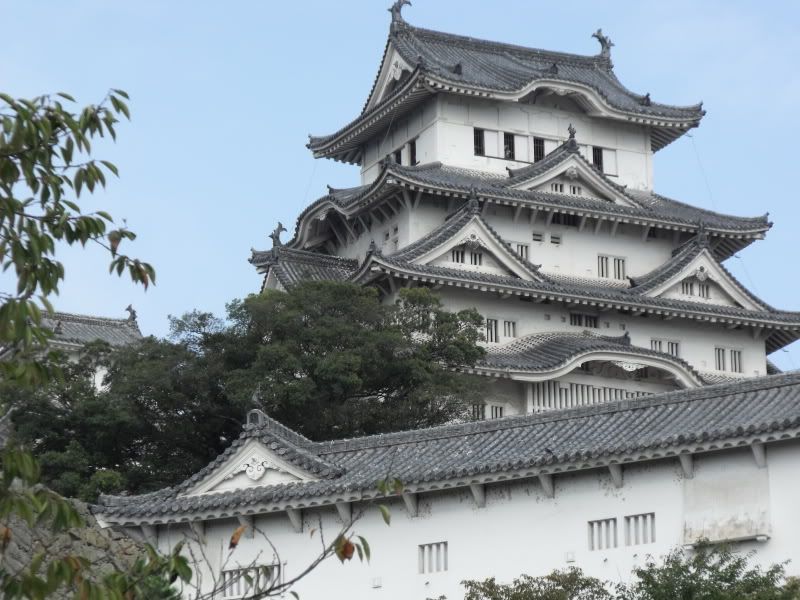 This six-storey castle was built in 1333 and has been restored many times since then, but they make sure to keep all the details. Like the wodden frame and white plaster walls. It's because of these white walls that the castle has been given the nickname of White Heron Castle (Shirasagijō).
This six-storey castle was built in 1333 and has been restored many times since then, but they make sure to keep all the details. Like the wodden frame and white plaster walls. It's because of these white walls that the castle has been given the nickname of White Heron Castle (Shirasagijō).If you think this castle looks familiar, chances are you've seen it before. The castle has been featured in many movies including James Bond: You Only Live Twice and The Last Samurai.
Sunday, January 3, 2010
Engrish
New Years in Japan
So, needless to say, my Christmas in Japan was quite tame. I was lucky enough to have the day off, and I spent the time talking with family in Canada. I also went shopping to get a few last minute things for the Christmas dinner Kris and I had with our friends. It wasn't a bad Christmas, just not a Christmas I'm used too. There wasn't even any snow!
But don't think just because there wasn't a grand Christmas that Japan is lacking on holidays. They have more than enough of their own. For starters, they have two four-day holidays; one in the spring called Golden week, and one in the fall called Silver week. They also have a whole slew of holidays thrown into their year. So many that it seems like I have a stat-holiday at least once a month. But the big Japanese holiday is New Years.
Un
While they do enjoy the festival, the big thing is to make an offering at the temple, ring the bell, and pray for good fortune for the upcoming year. After the prayer, you can purchase a multitude of charms and horoscopes. If you have a horoscope that predicts misfortune, you tie it to a tree (or any spot that has been dedicated to this custom). Some shrines (like the one we went to) also offer other mini-shrines you can make offerings to and pray to. These shrines are dedicated to a certain cause. For example, if you are a student preparing for your entrance exams for high school or university, you might make an offering to a shrine for education.
Visiting the shrine is only one of the new years traditions. The other main tradition is the family time. Children (no matter what their age) return to their parents' home. They usually stay from the first until at least the third. During this time, no cooking or cleaning is supposed to be done. Which means that the poor mother is cooking like a mad woman on the thirty-first so that everything is ready for the upcoming feasts. I don't know a lot about these feasts, but I do know a bit about the food. One common new years food is zoni, which is a special vegetable and chicken soup. This soup is made with toasted mochi (rice cakes). We made it for our new years dinner and it was really yummy. Definitely something we'll make again.
Other foods that are common to new years are these boxes filled with different types of vegetables and seafood, like whole shrimp. The boxes should be assembled at home, but you can buy them from stores in advanced and have them delivered to your home either on new years or just in time for new years. But these boxes don't come cheap. The grocery store in the mall was selling them for about $100. I think I saw even some at 7-11 for $35. I don't know the full story, but each food has a special meaning, like long life or prosperity or something else depending on the food. Each thing is supposed to help bring good luck in the new year, and chase off evil spirits.
Since all this time is being spent with the family, a lot of places are closed until the 3rd or 4th. It's not as bad as I thought it would be. My bank's ATMs are open, but I've noticed a few that are closed. The big chain stores are open, but a lot of the smaller, family owned places are closed. The buses and trains are running, but a lot of them are running on a holiday schedule. Even some of the tourist destinations are closed.
The stores that are open offer "Happy Bags." Depending on the store and the items, a happy bag can go for $5-$100. They are filled with items from the store. Each store has signs and pictures of what is in the happy bag. I've seen happy bags filled with candy, clothes, picnic supplies and even stuff for the kitchen. Its a pretty cool idea, and one that works really well with another new years tradition: money envelopes.
I guess its okay that they don't have Christmas, because they have this tradition instead. On New Years day, parents give their children, under the age of 20, envelopes filled with money. From what I've been told, the older you are, the more money you receive. Many of my jr high school students will get $30-$50. The envelopes here are really cute, too. They have many different designs, from flowers, to the animals of the Chinese zodiac, to popular characters like Disney Princesses and Thomas the train engine.
The last tradition that I know about is New Years cards. The idea behind them is similar to Christmas cards. You buy, or make, cards that wish the people in your life good luck in the upcoming year. These cards are such a big deal that the post office guarantees delivery of your cards in time for new years as long as you drop them off by a certain time. The only major difference between these cards and our Christmas cards is that they don't sell them in bulk. Of course, in North America, you can go to almost any store and buy a box of Christmas cards for a few dollars. In Japan, you can buy new years cards from most stores or the post office, but they all go for 50¢ a card. Which can get really expensive really fast. I know the teachers I work with are buying them not only for their friends and family, but also for their homeroom students and students that are in the clubs that they supervise.
Japanese New Years might not be as awesome as Christmas is, but its still really interesting to experience this culture and enjoy their holidays and traditions.
Friday, January 1, 2010
Welcome to 2010
Hello blog-verse and Happy New Year!
My resolutions for the new year is to post a new blog once a week. Starting with this Sunday. So hold onto your hat, dear readers, 2010 promises to be one heck of a ride!
My resolutions for the new year is to post a new blog once a week. Starting with this Sunday. So hold onto your hat, dear readers, 2010 promises to be one heck of a ride!
Subscribe to:
Posts (Atom)


